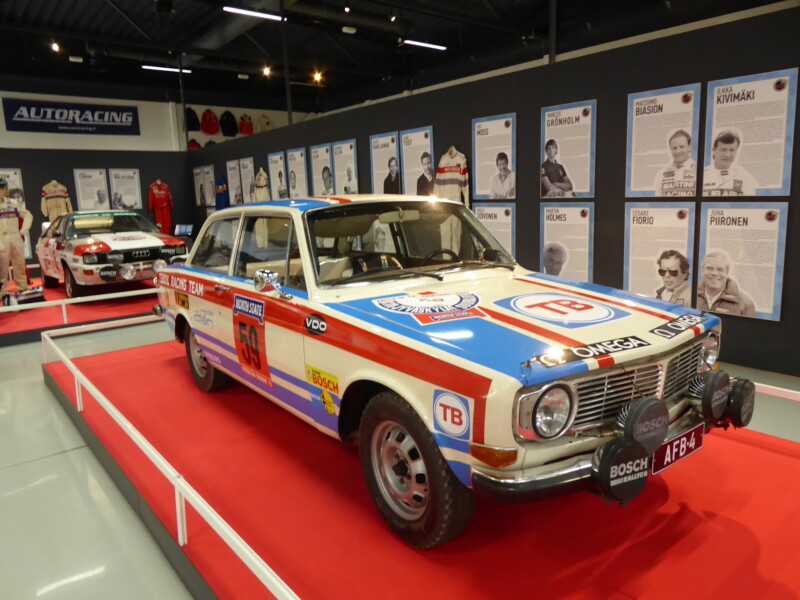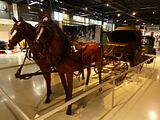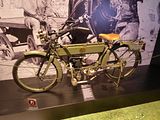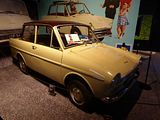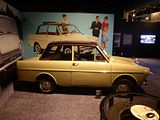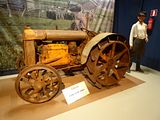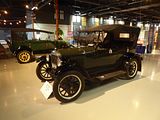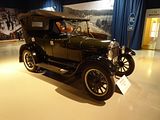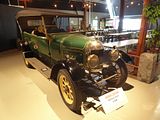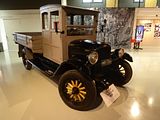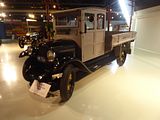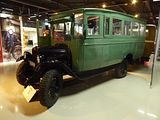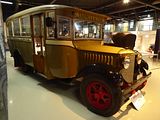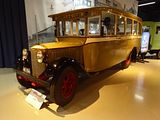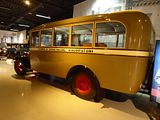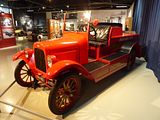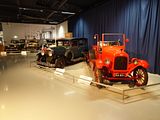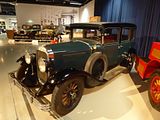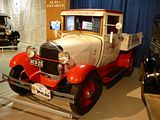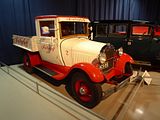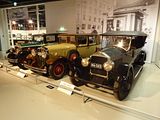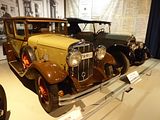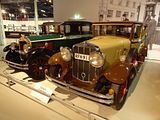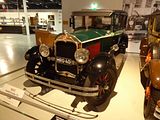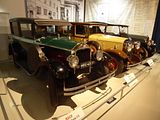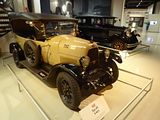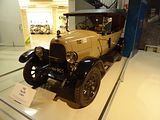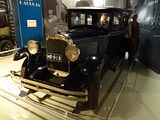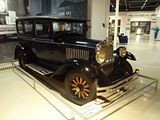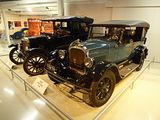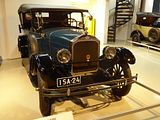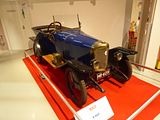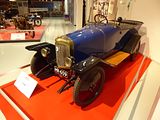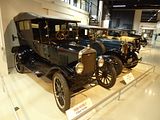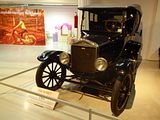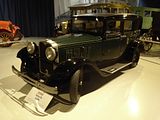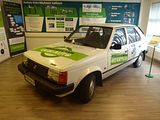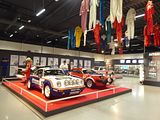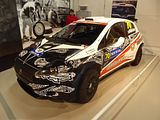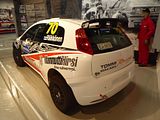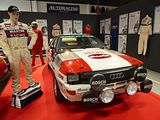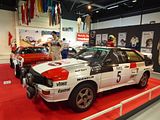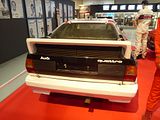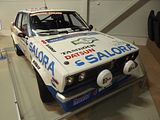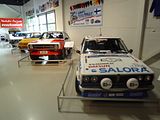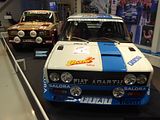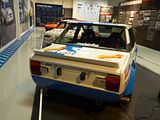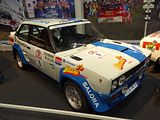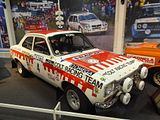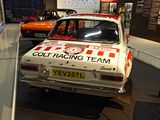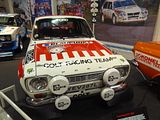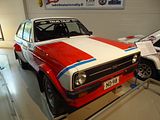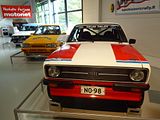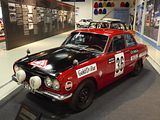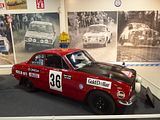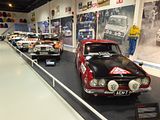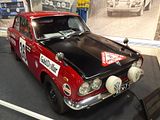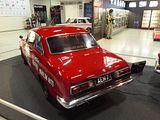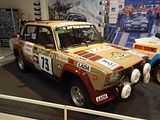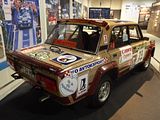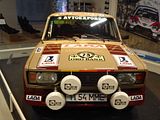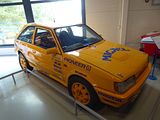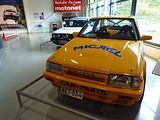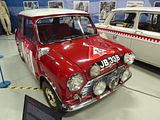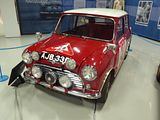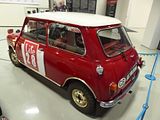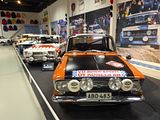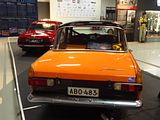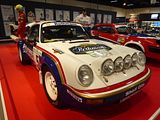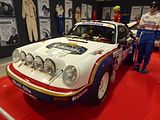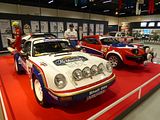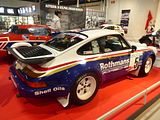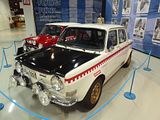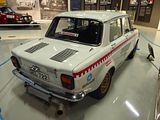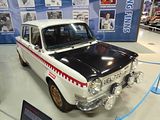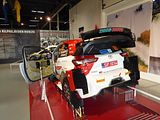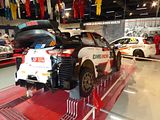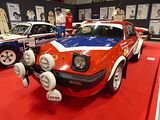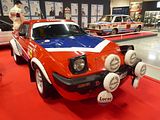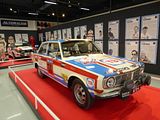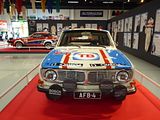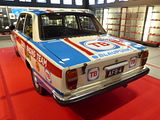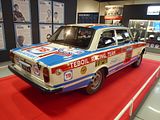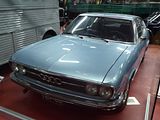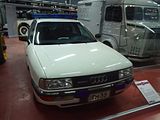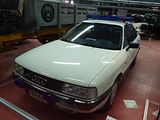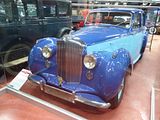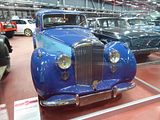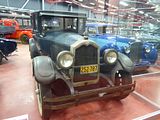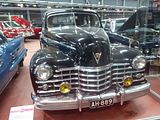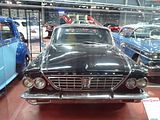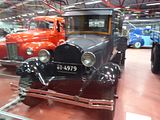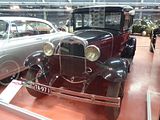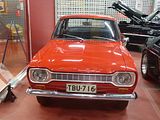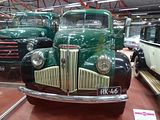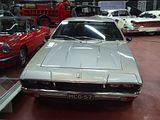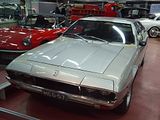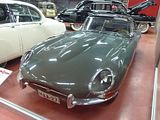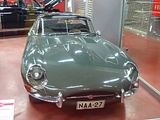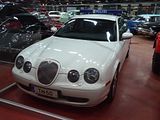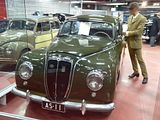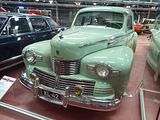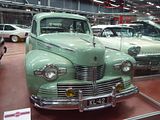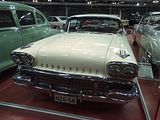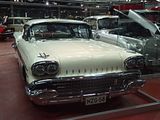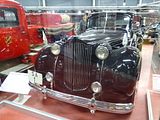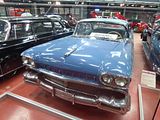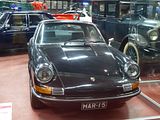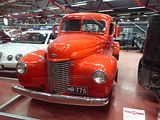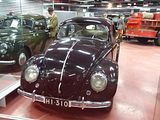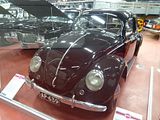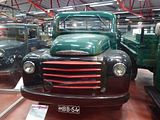When planning a week’s vacation in Finland in late summer, it was inevitable that I would spend some time looking to see if there were car museums that I could include during my trip. And pleasingly, there were, though by late September some of them have already closed for the winter. Open all year around, though, is this one, which is known as Mobilia. Located a few km off the main from Helsinki that heads towards Tampere and just outside a small town called Kangasala, and just a few km from the Vehoniemi Museum I visited earlier in the day, this turned out to be one of the most important car museums in the country.
The Mobilia Foundation was founded in 1986 by Olavi and Lilja Sallinen. Olavi Sallinen started his hobby with museum cars in the 1950s. Over the decades, his collections grew, and in 1982, he opened his first museum in Vehoniemenharju, Kangasala. The museum began to gain fame and glory under the name Vehoniemi Automobile Museum. In 1986, Lilja and Olavi Sallinen established the Vehoniemi Automobile Museum Foundation to support their museum activities, and around the same time, the foundation opened a second museum in Kangasala under the name Finnish Military and Special Vehicle History Museum. The establishment of the foundation and the expansion of the museum’s activities were made possible by Sallinen’s simultaneous relinquishment of the bulk of his extensive business activities. In 1991, the Vehoniemi Automobile Museum Foundation became a public foundation when A-Katsastus Oy (formerly the Central Motor Register), the municipality of Kangasala, the Ministry of Defence, and the Road Administration (formerly the National Board of Roads and Waterways) joined the foundation and agreed to establish a more comprehensive road transport museum. In this context, the Road Museum was added to the Foundation’s group of museums. The Vehoniemi Automobile Museum, the Finnish Museum of Military and Special Vehicle History, and the Road Museum adopted the name Mobilia in 1992. Mobilia moved from the Vehoniemi ridge to its new premises in Kisaranta, Kangasala, in 1994. In 1997, Mobilia achieved one of its key objectives when the Ministry of Education designated it as a national museum specialising in road transport. In 1999, the Vehoniemi Automobile Museum Foundation changed its name to Mobilia Foundation in line with its strategy. In 2002, Mobilia added collection hotel services to its service concept. In 2003, Mobilia’s collection hotel services were recognised with special merit in the Finnish Museum Quality Award competition, where Mobilia was the only museum to receive the award. In 2020, the Ministry of Education and Culture designated Mobilia as having national responsibility as the museum of road transport. Currently, the Mobilia Foundation brings together 29 road transport associations. There are two large museum halls, ne of which is split into two separate display areas and the site also includes extensive workshops where repair and maintenance work is undertaken.
The tour of the museum starts with transport before the arrival of the motorcar. Finland was a very rural country indeed, sparsely populated and without a road network and also blessed (or cursed) with long and cold winters. The sled was the way of getting about and here is an example.
Of course, the alternative was the horse and carriage and an example of that was also displayed here.
Gradually, roads were constructed, connecting the larger towns of the country together and people started to be able to travel about. Motorcycles were one way of doing this and this is an early example.
Quite a contrast was provided by the next exhibit, the Dutch built Daf. The DAF Daffodil is an economy small family car that was manufactured by DAF from 1961 until 1967. Together with the DAF 750, launched at the same time, it replaced the DAF 600. DAFs 750 was essentially the same car but with even fewer luxurious fittings and less chrome trim on the outside. Both the Daffodil and the 750 retained the Variomatic automatic transmission system as standard, which distinguished them from most other small and cheap cars on the market. The Daffodil was conceived as an export version of the 750; market response dictated that the 750 ceased production in 1963 while the Daffodil, benefitting from a succession of mild face lifts, remained in production until 1967. The Daffodil was replaced by the very similar but slightly more powerful DAF 33. The Daffodil name worked well in some markets, but in Germany the more luxuriously equipped version of the DAF 750 was known as the DAF 30. Upgrades in 1963 and 1965 were marked by name changes to DAF 31 and DAF 32. In these markets the launch of the DAF 33 in 1967 was a logical continuation of the existing line. The 746 cc four stroke air cooled 2 cylinder Boxer engine had the same stroke as in the 600, but the bore was increased from 76 mm to 85.5 mm. Claimed power output was also increased from 22 bhp to 30 bhp, with a claimed top speed of 105 km/h (65 mph). The 0-50 mph (80 km/h) time took 29 seconds, as tested by the Consumers Union in the United States. The DAF 600 was the first car mass-produced with a continuously variable transmission (CVT) – the innovative DAF Variomatic system. The same system was carried over to the 750, the Daffodil, and its variants. No conventional gearboxes were offered on the cars – all these economy cars came with this automatic transmission system as standard. The Variomatic employs centrifugal weights to control the drive ratio of the transmission and is enhanced by the engine manifold vacuum. The action of the bob weights and inlet vacuum combined to pull together the cheeks of two variable-diameter driving pulleys, driven directly from the engine. These were connected, by rubber ‘V’ belts, to two similar driven pulleys, connected to the drive wheels. The cheeks of the driven pulleys were held together by spring tension, which was progressively overcome as the drive pulleys expanded and the tension of the belts increased. The DAF Variomatics were thereby the only cars ever produced which went faster by the simple expedient of gently and gradually releasing the accelerator once top engine speed had been reached, because the increased vacuum took over from the reducing bob weight speed. The Variomatic also permitted increased engine braking by operating a switch on the dashboard to reverse the action of the vacuum on the pulley’s diaphragm, seeking a lower ratio with increased manifold vacuum. Two separate transmissions underneath the rear seat ran the two driving wheels – one on each wheel, eliminating the need for a differential, since belt slippage allowed for differing speeds of the inner and outer wheels in corners. Strictly speaking, this system worked like a rear transaxle, yielding a favourable weight distribution. The duplication also provided redundancy – if one belt broke, the vehicle would still be driven by one wheel. An incidental feature was that in reverse (at least for earlier examples) the system allowed the same top speed to be driven as going forwards. Later cars locked the transmission in the lowest ratio when reverse was selected. Between 1961 and 1967 the mechanical aspects of the car were not significantly changed. 1963 marked the withdrawal of the 750 and 30 badges, and the DAF 30 was replaced by the DAF 31. The exterior of the car was modestly reworked with input from Giovanni Michelotti which involved sharpened angles and more prominent fins: the interior was also significantly upgraded. In 1965 the DAF 32 replaced the DAF 31. This upgrade was marked by further limited changes to the body panels, again involving Michelotti whose influence would continue to be seen on DAF passenger cars until the Limburg car assembly business was acquired by Volvo.
1920 – 30 Fordson Model N Tractor: Fordson was a brand name of tractors and trucks. It was used on a range of mass-produced general-purpose tractors manufactured by Henry Ford & Son Inc from 1917 to 1920, by Ford Motor Company (U.S.) and Ford Motor Company Ltd (U.K.) from 1920 to 1928, and by Ford Motor Company Ltd (U.K.) from 1929 to 1964. The latter (Ford of Britain) also later built trucks and vans under the Fordson brand. After 1964, the Fordson name was dropped and all Ford tractors were simply badged as Fords in both the UK and the US. Between 1917 and 1922, the Fordson was for tractors somewhat like the Ford Model T was for automobiles—it captured the public’s imagination and widely popularized the machine, with a reliable design, a low price affordable for workers and farmers, a widespread dealership network, and a production capacity for large numbers. Just as the Model T helped the public to appreciate how soon cars and trucks might replace most horses in transport, the Fordson helped people to appreciate how soon tractors might replace most horses in farming (advancing the mechanization of agriculture). As with cars, Ford never had the market to itself, but it dominated the market for tractors, from roughly 1917–1925, and again from 1946-1953. Ford was the only automotive firm to sell cars, trucks, and tractors simultaneously from 1917 to 1928. For a decade between 1928 and 1939, Ford of the U.S. left the tractor business. During that decade, Ford of Britain continued to build Ford and develop new variants, which it exported widely. The Fordson Model N replaced the Fordson Model F. It was an improved variant of the F. Production of the Model N started in Cork in 1927. Production of the Fordson Model N was transferred from Cork to Dagenham in 1933. The Model N featured a 27 HP engine, standard rear fenders (mudguards), a higher voltage ignition system, and optional pneumatic tires. In 1935 power take-off (PTO) was available as an option on the Model N. The Fordson Model N was probably the most important tractor in the United Kingdom during World War II. The Dagenham plant produced over 136,000 Model N tractors during the war. Ford of the U.S. also exported Model 9N tractors to the U.K. during the war
1926 Ford Model T Touring: The Ford Model T was produced by the Ford Motor Company from October 1, 1908, to May 26, 1927. It is generally regarded as the first affordable automobile, which made car travel available to middle-class Americans. The relatively low price was partly the result of Ford’s efficient fabrication, including assembly line production instead of individual handcrafting. It was mainly designed by an American (Childe Harold Wills) and two Hungarian engineers (Joseph A. Galamb, Eugene Farkas). The Model T was colloquially known as the “Tin Lizzie”, “Leaping Lena” or “flivver”. The Ford Model T was named the most influential car of the 20th century in the 1999 Car of the Century competition, ahead of the BMC Mini, Citroën DS, and Volkswagen Beetle. Ford’s Model T was successful not only because it provided inexpensive transportation on a massive scale, but also because the car signified innovation for the rising middle class and became a powerful symbol of the United States’ age of modernization. With 15 million sold, it was the most sold car in history before being surpassed by the Volkswagen Beetle in 1972, and still stood eighth on the top-ten list, as of 2012.
1926 Morris Oxford Tourer: The 1919 Oxford (advertised as early as September 1918) was assembled from locally made components and now took on the rather more substantial aspect of 1915’s Cowley. Longer and stronger than the old Oxford, enough to carry five passengers, the new Oxford retained the pre-war Bullnose radiator style in its larger version. From August 1919, the Cowley became the downmarket “no frills” variant with only a 2-seater body and lighter smaller tyres. The Oxford had a self-starter (an extra for the Cowley) and a better electrical system and the Oxford took and kept the Cowley’s leather upholstery. The new car’s 11.9 fiscal horsepower 1548 cc engine was made under licence in Coventry for Morris by a British branch of Hotchkiss the French ordnance company which was turning away from guns to the motor industry. The Hotchkiss engine used the Cowley’s Detroit USA Continental Motors Company design. Hotchkiss prices well undercut White and Poppe who had made Oxford engines up to that time. Morris bought Hotchkiss’s British factory in May 1923 and named it Morris Engines. When it was shown at the Scottish Motor Show in January 1920 it drew large crowds of enthusiasts all day. The chassis alone was shown and was genuinely admired for the way all transmission, everything revolving, was fully enclosed in what amounts to an oil bath, everything but the fan belt. A few weeks later after a lengthy trial of the new car The Times’ motoring reporter wrote that the car represents “a very decided advance in light car construction”. The common sense of the designers is shown in many small details but “its greatest charm is in the engine’s steam-like flexibility” and liveliness. In these respects it was the best engine the writer had ever encountered. Later in 1926, a new “flatnose” model was introduced, replacing the distinctive Bullnose which had been a feature since the first Morris of 1913.
1928 Chevrolet C26 A48 Capitol Truck: The Chevrolet Series AA Capitol (or Chevrolet Capitol) is an American vehicle manufactured by Chevrolet in 1927. Launched in the year Ford changed from the Model T to the Model A, Chevrolet sold 1,001,820 Series AA cars, and under the direction of General Manager William S. Knudsen Chevrolet would overtake Ford’s dominance in the market internationally. The GM introduction of the GM A platform also introduced yearly appearance changes while using a corporate appearance from the newly established Art and Color Section headed up by Harley Earl which meant the Chevrolet Capitol and the Cadillac Series 314 shared a common appearance as both cars, as well as Oakland, Oldsmobile and Buick used Fisher Body, now owned by GM, as the sole provider of coachwork. Individuality between the brands was defined by the manufacturer of the engine, which was brand exclusive, and badging on the radiator. This model documents that the accelerator pedal was introduced as previous generations used a throttle installed in the centre of the steering column along with the installation of a gas gauge installed in the dashboard and a centrally installed rear view mirror. Available in eight body styles, the bodywork was very similar to the 1926 Chevrolet Superior Series V and 1925′s Superior Series K. The chassis and platform were also used to build Chevrolet and GMC trucks. In May of 1925 the Chevrolet Export Boxing plant at Bloomfield, New Jersey was repurposed from a previous owner where Knock-down kits for Chevrolet, Oakland, Oldsmobile, Buick and Cadillac passenger cars, and both Chevrolet and G. M. C. truck parts are crated and shipped by railroad to the docks at Weehawken, New Jersey for overseas GM assembly factories.
1928 Chevrolet Capitol Bus
1928 International Bus
1923 Chevrolet Superior Fire Truck
1929 Buick Master Six Sedan: The Buick Master Six Series 40 and Series 50, based on the wheelbase used, was an automobile built by Buick from 1925 to 1928 and shared the GM B platform with the Oldsmobile Model 30. Previously, the company manufactured the Buick Six that used the overhead valve six-cylinder 242 cu in (4.0 L) engine in their high-end cars, and the Buick Four for smaller, less-expensive cars. Starting with 1918, they dropped the four-cylinder engine and designed a small six, which they called the Buick Standard Six, to replace that end of the market. They coined the name “Master Six” for the high-end cars, now powered by the 255 cu in (4.2 L) engine released the year before. The yearly changes were a result of a new business philosophy called planned obsolescence. As GM was sharing platforms and technology within their divisions, the Master Six was related to the Oldsmobile Model 30 with shared wheelbase and engine sizes. Buick had developed a market reputation as being a conservative luxury car, while the Cadillac and the Packard Six were more flamboyant, extravagant and expensive. The last Emperor of China Puyi bought 2 1924 Master Six and started the trend of being China’s most popular car. To promote its durability Buick President Harry H. Basset had a Touring Sedan driven around the world via a dealer-to-dealer network, where each location was responsible for driving the car to the next destination and having the log book signed for authenticity. 1927 saw the introduction of the Gothic Goddess hood ornament on all Buick products. The top of the radiator grille adopted a scalloped look that blended into the top of the engine cover which differed from both Oldsmobile and Cadillac sedans of the same year and was only offered from 1925 until 1928. It shared a similar appearance on all Packard products that first appeared in 1904 on the Packard Four, and the recently introduced Chrysler Imperial. Buick named their six-cylinder cars “Buick Six” from 1916 through 1924, and in 1925, divided them into Standard Six and Master Six. The Master 6 used Series 121 and 129 designations in 1929 initially to denote the wheelbase dimensions, then renamed the Series 40 in 1930. All were powered by the overhead valve Buick Straight-6 engine, with multiple body styles, and starting in 1926 used the newly established GM B platform, which it shared with Oldsmobile L-Series. Coachwork continued to be offered by Fisher Body who was the primary supplier of all GM products at this time, and Duco automotive lacquer paint, introduced by DuPont was the first quick drying multi-colour line of nitrocellulose lacquers made especially for the automotive industry. Although Buick produced mostly four-cylinder cars in the teens and early ’20s, as it had been doing, the new six-cylinder cars became more common industry wide. Buick first made six-cylinder cars in 1914, with a 331 cu in (5.4 L) engine, which was originally a racing engine, later used in limited production as the Series 50. The 331 cu in (5.4 L) engine was dropped in 1916 and replaced with the much smaller Series 40 engine, starting with a 224 cu in (3.7 L) in 1916 and 1917, the 242 cu in (4.0 L) engine from 1918, increased to 255 cu in (4.2 L) in 1924, increased again to 274 cu in (4.5 L) for 1926 through 1928. The engine was increased again to 309 cu in (5.1 L) for the Series 121 and 129 in 1929 and Series 40 in 1930, after which all six-cylinder engines were suddenly dropped and all models of Buick were equipped with the legendary Straight 8, starting in 1931 and for decades thereafter. Roadsters and touring sedans had the ability to fold the windshield forward on top of the cowl for open air driving. Buick’s special order catalog was more modest than the Cadillac Series 341, but it did benefit from the specialized bodies made by Fisher Body which gave the Buick customer the same attention to style and refinement but at a modest price. The top level choice for the longest Buick wheelbase of 129″ was the Imperial Sedan Limousine for US$2145. The Master Six was Buick’s high-end offering, above the Standard Six. It was also manufactured from knock-down kits at GM’s short-lived Japanese factory at Osaka Assembly in Osaka, Japan. The Master Six was also sold with a junior model, called the Standard Six which were renamed in 1929 as the Series 116, and Series 121
1929 Ford Model A Pickup: The Ford Model A was the Ford Motor Company’s second market success after its predecessor, the Model T. First produced on October 20, 1927, but not introduced until December 2, it replaced the venerable Model T, which had been produced for 18 years. This new Model A (a previous model had used the name in 1903–04) was designated a 1928 model and was available in four standard colours. By February 4, 1929, one million Model As had been sold, and by July 24, two million. The range of body styles ran from the Tudor at US$500 (in grey, green, or black) to the Town Car with a dual cowl at US$1200. In March 1930, Model A sales hit three million, and there were nine body styles available. Prices for the Model A ranged from US$385 for a roadster to US$1400 for the top-of-the-line Town Car. The engine was a water-cooled L-head inline four with a displacement of 3.3 litre. This engine provided 40 bhp. Top speed was around 65 mph (105 km/h). The Model A had a 103.5 in (2,630 mm) wheelbase with a final drive ratio of 3.77:1. The transmission was a conventional unsynchronized three-speed sliding gear manual with a single speed reverse. The Model A had four-wheel mechanical drum brakes. The 1930 and 1931 models were available with stainless steel radiator cowling and headlamp housings. The Model A came in a wide variety of styles including a Coupe (Standard and Deluxe), Business Coupe, Sport Coupe, Roadster Coupe (Standard and Deluxe), Convertible Cabriolet, Convertible Sedan, Phaeton (Standard and Deluxe), Tudor Sedan (Standard and Deluxe), Town Car, Fordor (five-window standard, three-window deluxe), Victoria, Town Sedan, Station Wagon, Taxicab, Truck, and Commercial. The very rare Special Coupe started production around March 1928 and ended mid-1929. The Model A was the first Ford to use the standard set of driver controls with conventional clutch and brake pedals, throttle, and gearshift. Previous Fords used controls that had become uncommon to drivers of other makes. The Model A’s fuel tank was situated in the cowl, between the engine compartment’s fire wall and the dash panel. It had a visual fuel gauge, and the fuel flowed to the carburettor by gravity. A rear-view mirror was optional. In cooler climates, owners could purchase an aftermarket cast iron unit to place over the exhaust manifold to provide heat to the cab. A small door provided adjustment of the amount of hot air entering the cab. The Model A was the first car to have safety glass in the windshield. Model A production ended in March 1932, after 4,858,644 had been made in all body styles. Its successor was the Model B, which featured an updated inline four-cylinder engine, as well as the Model 18, which introduced Ford’s new flathead (sidevalve) V8 engine.
1927 Pierce-Arrow Model 80: Owning a Pierce-Arrow was a status symbol for many of the roaring twenties elite. Any one of their exclusive vehicles was synonymous with excellence, luxury, and well-built design. The Pierce-Arrow Motor Company was the leader in the luxury car field, but they also manufactured fire trucks, motorcycles, commercial trucks, camp trailers, and bicycles. Their claim to fame lay in their smooth, silent, and enormous six-cylinder engines coupled with superb workmanship and dedication that went into each and every vehicle produced. Pierce-Arrow body designs were incredibly strong and lightweight thanks to cast aluminium body panels as thin as 1/8-inch. The perfect casting techniques were a result of the close brotherhood formed between Pierce-Arrow and its Buffalo neighbour Aluminum Company of America. The artistic Herbert Dawley is credited for the body design as well as the eventual Pierce-Arrow trademark, the headlights faired into the tops of the front fenders. In 1924 the Model 80 debuted on the scene as the sportiest four-passenger Pierce of its era. Attempting to gain new customers, it was first introduced as a smaller ‘owner-driver’ companion to the T-head dual-valve six, which was introduced following the armistice. Three years later the marque featured the aluminum-bodied Model 80 with four-wheel vacuum-powered brakes. The fuel gauge was found on the gas tank while the temperature gauge was placed on the dashboard. Smaller and simpler in design than the Series 33 cars, the Model 80 was a much less expensive alternative for luxury enthusiasts. It also proved to be more popular than the Series 33 as the Series 80 far outsold it. The 80 actually became Pierce-Arrow’s most popular model ever as it sold over 16,000 models between 1924 and 1927. Powering the Model 80 was a more conventional 288.6 cubic inch L-head six-cylinder instead of the marques long-standing dual-valve T-head motor. Rather than a pressure system, a Steward vacuum tank was used to supply fuel. Using a reed-valve carburettor similar to the Series 33 cars, only one set of valves and a single ignition system were used. Setting the Pierce-Arrow cars apart from its competition was the visual identity found in the headlamp set integrated into the skirts, a feature found on the Model 80. The luxury vehicle featured a straight windshield, a triple-lamp taillight, and vertical hood louvers. Custom bodies of the Model 80 were available from LeBaron, Judkins, and Brunn to name a few of the coachbuilders. In the 1920s the Model 80 sold between $2,895 and $4,045. The Model 80 was replaced with the Series 81 in 1928. Unfortunately though for the Pierce-Arrow marque, the styling by new designer James R. Way was not well received by the esteemed Pierce-Arrow clientele and the sales fell dramatically.
1928 Franklin 135 Sport Sedan
1928 Buick Standard Six Series 115 2 door Sedan: The Buick Standard Six Series 20 was manufactured by Buick at what would later become known as the Buick City factory on Hamilton Ave. in Flint, Michigan, and was the junior model to the Buick Master Six between 1925 through 1929, and shared the GM A platform with Oldsmobile, Oakland and Chevrolet. The Standard Six evolved from the earlier Buick Six when the Buick 4-cylinder was cancelled. The Standard Six was the most popular Buick sold while being more upscale to the Oldsmobile Six. It was the senior brand to Marquette under the General Motors Companion Make Program until Marquette was cancelled one year later. It replaced the earlier Buick Six that was introduced in 1916, and was replaced with the Buick Series 50. Coachwork continued to be offered by Fisher Body who was the primary supplier of all GM products at this time, and Duco automotive lacquer paint, introduced by DuPont was the first quick drying multi-colour line of nitrocellulose lacquers made especially for the automotive industry.
1925 Fiat 501: The Fiat 501 is a car produced by Fiat between 1919 and 1926. The 501 was Fiat’s first model after World War I. Fiat introduced the S and SS sports versions of the 501 in 1921. Fiat produced 47,600 501s in total.
1928 Studebaker Dictator: The Studebaker Dictator is an automobile produced by the Studebaker Corporation of South Bend, Indiana, United States from 1927 until 1937. Model year 1928 was the first full year of Dictator production. In the mid-1920s, Studebaker began renaming its vehicles. The model previously known as the Studebaker Standard Six became the Dictator during the 1927 model year—internally designated model GE. The name was intended to connote that the model “dictated the standard” that other automobile makes would be obliged to follow. Dictators were available in a full range of body-styles. The Dictator was Studebaker’s lowest-price model, followed (in ascending order) by the Studebaker Commander and Studebaker President series. There was also a Chancellor model in 1927, but that year only. In June 1929, Studebaker began offering an 8-cylinder engine for the Dictator series (221 cubic inches, 70 bhp at 3,200 rpm), designed by Barney Roos, though the old 6-cylinder option was continued for another year. There was no 1933 Dictator due to Studebaker’s bankruptcy, and a redesigned lower-priced model was released in 1934 with a 6-cylinder engine. The 8-cylinder engine was then on only available for the Commander and President models.
1924 Rugby Model F Touring: The Rugby was a brand of automobiles assembled by the Durant Motors Company of New York City, New York (USA). Beside badges and right-hand drive for some models, the vehicle was identical to Durant’s Star car, and was assigned to export markets by Durant Motors, due to the name Star being under copyright by the Star Motor Company in the British Commonwealth. The Rugby was built from 1923 based on the Star car and production ended in 1928 together with the Star. The Star name was changed to Durant and all 4-cylinder Durants exported carried the Rugby name until the end of the Durant line in Canada in 1932. Commercial cars were marketed based on the Rugby. Some Durant commercial vehicles were badged Rugby’s and sold in the US for 1928. Commercial trucks from January 1928 were Rugby’s to the end of production in 1933 at Dominion Motors in Leaside. The last remaining US plant in 1931 was Lansing which stopped in August 1931. Leaside became Canadian owned in January 1931, as Dominon Motors, Ltd. and they chose to continue the Durant into 1932 and Rugby into 1933.REO cars were also built there beginning in 1932. In August 1931, Dominion made the Canadian Frontenac car to the end of 1933. All production stopped in December 1933. The company charter was finally surrendered in 1944.
1922 Koco
1921 Ford Model T Tourer
1928 Dodge Viceroy Six
A display hall off the main area focused on car production, specifically in Finland. People will be surprised, perhaps, to learn that in the early 80s, production included the Talbot Horizon, as seen here, as well as the larger Alpine and Solara models, which were assembled at the Valmet plan t in Uusikaupunki, not that far away from this museum, and a place I would visit later in the trip.
THE RALLY MUSEUM
With Finland producing large numbers of world renowned rally drivers as well as regularly hosting some epic events in its countryside, a Rally Museum would seem a logical thing to include and following a successful crowd-funding campaign, Mobilia was able to add a Rally Hall to the museum. There was quite a mix of cars in here, from the familiar to the less expected, and there was lots of rallying memorabilia around the sides of the displays. I understand that the museum regularly hosts special displays so these were the cars that were on show during my visit but you may well see something different when you go.
Abarth Grande Punto
Audi Quattro, ex Michele Mouton
Datsun Violet 160J
Fiat 131 Rally
Ford Escort Mark 1
Ford Escort Mark 2
1969 Isuzu Bellett GT: The Isuzu Bellett is a subcompact car produced between 1963 and 1973. Designed by Isuzu, the Bellett replaced the Isuzu Hillman Minx, manufactured by Isuzu under license with the Rootes Group. The car was available as a four-door or two-door sedan, a rare two-door station wagon marketed as a commercial vehicle, called the Bellett Express, and an even rarer one ton commercial variant marketed as the Isuzu Wasp. There was also a four-door sedan with different bodywork and rear suspension, called the Bellett B. Lastly there was a two-door coupé and a fastback version of the same. After General Motors acquired a stake in Isuzu, the Bellett was replaced by GM’s “global” T-car, initially called Isuzu Bellett Gemini and later simply Isuzu Gemini, which technically had little to do with its predecessor. A total of 170,737 original Belletts were manufactured. The word Isuzu translated into English means “fifty bells.” The nameplate “Bellett” referred to “a smaller Bellel”, a previous, larger model manufactured by Isuzu. Launched in June 1963, the sedan used a 1.5 L OHV Inline-four petrol engine and a 1.8 L diesel engine. The 49 bhp diesel received very low gearing of 4.1:1 – optionally available to the 1.5 as well – resulting in a top speed of only 104 km/h (65 mph). In April 1964, they were joined by the 1.3 L OHC inline-four engine already in use in the Wasp pickup truck, at which time a three-door van/wagon version called the Express (in Japan) was also added to the lineup. In 1966, a mild facelift featured a revised front fascia, and the Bellett B model was added. At the very end of 1966, a 1.6 litre SOHC engine was added for the 1600 GT. In 1971 the Bellett range underwent a second facelift, which also marked the end of diesel-powered Belletts. The Bellett was the first Isuzu to be exported to Europe, when a thousand cars were shipped to Finland in January 1965. Isuzu entered The Swiss market after exhibiting at the 1965 Geneva Salon. The Finnish importer also marketed Alfa Romeos and Jaguars, and accordingly used competition as their main advertising method. The Isuzu Bellett was the first Japanese car to be regularly imported to Sweden. Exports to Canada also started in March 1965 as well. A 1.6-litre sedan line was assembled in New Zealand by Campbell Industries at Thames from 1968 to 1970. Initial production featured a silver grille and squared tail lamps; a facelift brought a new black grille and longer, rectangular tail lamps. The car was imported under ‘300 club’ rules which encouraged assembly of up to 300 units a year, using as many locally made parts as possible. Isuzu car assembly stopped after GM took its stake; the next Isuzu to be built and sold in New Zealand was the 1977 Gemini, marketed by GMNZ as an Isuzu rather than a Holden as in Australia. The Bellett was assembled under license by Francisco Motors Corporation in Las Piñas, Philippines from 1965 to 1974. As part of Isuzu’s advertising effort in Finland, rallies and car orienteering events were entered. A Group 2-tuned four-door Bellett surprised many European commentators by finishing a “sensational” tenth in the 1966 1000 Lakes Rally.
Lada Riva
Mazda 323
Mini Cooper
Moskvitch
Porsche 911 Safari
Simca 1000 Rallye 2
2017 Toyota Yaris WRC: this is Kalle Rovanperä’s Toyota Yaris WRC2017. The car in question is the one in which Rovanperä won the 2021 Rally Estonia, which was the seventh round of the 2021 World Rally Championship. For the first time ever, the winning car is on display outside Toyota Gazoo Racing’s operations and premises.
Triumph TR7
Volkswagen Golf
1971 Volvo 142
MOBILIA CLASSICS
A completely separate building, known as the Fenno Gallery, a few minutes walk from where you start your visit houses a collection of around 30 cars with more memorabilia around the sides of the displays. Care is taken to provide diversity among the cars on show and indeed some of the cars are changed periodically. Frustratingly, the cars were largely presented behind some glass screens which not only made seeing the properly a bit of a challenge, but also proved very problematic for the photographer. Presented here is the best I could do.
Alfa Romeo Spider S3: The Series 3 Spider was previewed in North America for the 1982 model year with the introduction of 2.0 litre Bosch electronic fuel injection to replace the SPICA mechanical injection. The Spider underwent a major styling revamp in 1983, which saw the introduction of black rubber front and rear bumpers. The front bumper incorporated the grille and a small soft rubber spoiler was added to the trunk lid. The change altered the exterior appearance of the car considerably and was not universally praised by enthusiasts. Various other minor mechanical and aesthetic modifications were also made, and the 1600 car (never available in North America) dropped the “Junior” name. The Quadrifoglio Verde (Green Cloverleaf) model was introduced in 1986, with many aesthetic tweaks, including sideskirts, mirrors, new front and rear spoilers, hard rubber boot mounted spoilers with integral 3rd stoplight, unique 15″ alloys and optional removable hardtop. Different interior trim included blood red carpets and grey leather seats with red stitching. The QV was offered in only 3 colours: red, silver and black. It was otherwise mechanically identical to the standard Spider Veloce model, with a 1962 cc double overhead cam, four-cylinder engine (twin two-barrel carburettors in Europe; North American models retained the Bosch L-Jetronic fuel injection introduced for the 1982 model year except that the VVT mechanism was now L-Jet activated) and five-speed manual transmission. The interior was revised with a new centre console, lower dash panels (to meet U.S. regulations) and a single monopod gauge cluster (with electronic gauges). For the North American market a model dubbed the Graduate was added in tribute to the car’s famous appearance in the 1967 film, The Graduate, starring Dustin Hoffman. The Graduate was intended as a less expensive “entry-level” Alfa. While it had the same engine and transmission as the Quadrifoglio and Veloce, it lacked the alloy wheels and luxury features of the other two models. The Graduate model had manual windows, basic vinyl seats, a vinyl top, and steel wheels as standard. Air conditioning and a dealer-installed radio were the only options. It first appeared in 1985 in North America and continued until 1990. Minor changes occurred from 1986 to 89, including new paint colours, a centre high mount stop lamp midway through 1986 for North American models, a move away from the fade-prone brown carpet and new turn signal levers. Some 1988 models featured automatic seatbelts that extended from a large device between the front seats. It was replaced by the Series 4 car in 1990.
1972 Audi 100 Coupe S: The Audi 100 Coupé S is a sports fastback coupe Grand tourer class car manufactured by the German automaker Audi AG. The car was first presented at the Frankfurt Motor Show in 1969. The car came with a 4-cylinder in-line engine with a capacity of 1871 cc and was initially equipped with two carburettors with power output of 115 hp. In 1972, it changed to a single carburettor with 112 hp output. 30,687 units were produced.
1987 Audi 90 Quattro Polis: In 1987, the Audi 90 was reintroduced as an upmarket, more luxurious variant of the 80. To begin with it would again feature a choice of 10-valve inline five-cylinder petrol engines, and could be specified with or without quattro. The 90 differs visually to the 80 by a full width tail-light panel; headlights which featured additional high-beam lights and a slightly different front grille. Indicator lamps were moved from beside the headlights to the bumpers next to the fog lights, which were standard fitment on the 90. Brightwork surrounds for the windows, tops of the bumpers and side rubbing strips were also standard. Interiors were upgraded over the 80 featuring velour seat coverings and a slightly more generous level of equipment. The then range-topping 2.2E offered a boot spoiler, alloy wheels, leather steering wheel and sports front seats. Switchable ABS was standard on quattro versions. From 1989 to 1991 the Audi 90 offered the first 20-valve engine from Audi since the turbocharged engine used in the Audi Sport Quattro. This new 2.3 litre engine produced 170 PS and featured in the front wheel drive 20V, 20V Sport and four-wheel drive 20V quattro derivatives. The non-quattro 20V models were 120 kg lighter. Externally, Sport versions of the 90 were visually distinguished by the deletion of brightwork in favour of satin black window surrounds, bumper cappings and thinner side mouldings. A raised aluminium boot spoiler, lowered suspension and uprated brakes were fitted as standard, Speedline wheels were also standard fitment in the UK. When the B4 family emerged in 1996, all the cars were badged as the A4.
1948 Bentley Mark VI: The Bentley Mark VI is an automobile from Bentley which was produced from 1946 until 1952. The Mark VI 4-door standard steel sports saloon was the first post-war luxury car from Bentley. Announced in May 1946 and produced from 1946 to 1952 it was also both the first car from Rolls-Royce with all-steel coachwork and the first complete car assembled and finished at their factory. These very expensive cars were a genuine success; long-term, their weakness lay in the inferior steels forced on them by government’s post-war controls. In 1944 Rolls-Royce executive W. A. Robotham saw that there would be limited postwar demand for a Rolls-Royce or Bentley rolling chassis with a body from a specialist coachbuilder, and negotiated with the Pressed Steel Company a contract for a general-purpose body to carry four people in comfort on their postwar chassis behind a Rolls-Royce or Bentley radiator. Though he stretched the demand to 2000 per year, Pressed Steel were “nonplussed” by the small demand. Chassis continued to be supplied to independent coachbuilders, which produced four-door saloon, two-door saloon and drophead coupe models. Out of the coachbuilt cars the most sought after now are the 241 cars built by H.J. Mulliner. This first Bentley factory finished car was given the name Bentley Mark VI standard steel sports saloon. This shorter wheelbase chassis and engine was a variant of the Rolls-Royce Silver Wraith of 1946 and, with the same standard steel body, became the cautiously introduced Silver Dawn of 1949. In 1952 both Rolls-Royce Silver Dawn and Bentley Mk VI standard steel bodies were modified to incorporate a boot of about twice the size and the result became known as the R type Bentley based on the Chassis number at which the change took place. The name of the Rolls-Royce Silver Dawn was not changed after the modification that started with the “E” series in these cars. A very few Mark VI engines and chassis were modified to provide higher performance and sold to be bodied by selected coachbuilders as the first Bentley Continentals (see below). The Mark VI 4+1⁄4-litre used an F-head straight-6 engine 4.3 L (4,257 cc) in size. The manufacturer refused to disclose a horse power value for the car (other than Tax Horsepower of 29.4 hp according to the old RAC formula) but an Autocar Magazine road test reproduced in 1950 reported that top gear provided “flexibility down to 6 mph (10 km/h)” and the ability to “climb a hill of 1 in 9 maximum gradient, complicated by bends”, all of which supported the manufacturer’s contention that power, along with low speed torque, were adequate. In 1951, a 4+1⁄2-litre, 4.6 L (4,566 cc) version of the engine was introduced. The increase in displacement was accomplished by increasing the bore from 3+1⁄2-inch to 3 5/8 inch. The later version is sometimes casually referred to as the “big bore” engine, the earlier version as the “small bore” version. The 4 1/2 L version of the engine is as well equipped with a Vokes 30 (later: Vokes 62) full flow oil filter (some earlier 4 1/4 L cars have since been modified to a full flow filtration system). Carburation in RHD (right hand drive) cars were two horizontal constant-vacuum SU carburettors (type H4 up to B81HP, type H6 from B83 HP on). LHD (left hand drive) cars had a single dual downdraught Stromberg carburettor type AAV26M and a different inlet manifold as fitted in the Rolls-Royce Silver Dawn and Silver Wraith. A four-speed synchromesh manual transmission was fitted in all Bentley MK VI with the change lever to the right of the driver on RHD cars and on the column on LHD versions. 4+1⁄4-litre cars had chassis numbers from B 1 AJ through B 400 LJ, with the final two letters indicating the series in which it was built. The “big bore” cars serial numbers begin with B 1 MB (although B 2 MD was the first big bore Mark VI built) and ended with B 300 PV (although B 301 PU was the last one built). Each alphabetic series only contained either even or odd numbers, and 13 was always skipped for the odd-numbered sequences. The 4.3 L was referred to as the 4+1⁄4 L and can be quickly identified from its single exhaust in RHD cars. The 4.6 L is known as the 4+1⁄2 L and features a twin exhaust in RHD cars. In LHD cars the (much less restrictive) twin exhaust system was only fitted with the introduction of the R-type. In addition for “standard steel” Mark VI saloons the single hinged ventilation flap centrally mounted on the top of the bonnet, directly ahead of the windscreen was replaced, on later cars, with two hinged ventilation flaps, mounted at or slightly below knee height, one on each side of the bonnet, ahead of the front doors. The oil filler cap is another way to identify engine type; a plastic cap is typical of a “small bore” engine, a metal cap of a “large bore” engine. The chassis used leaf springs at the rear and independent coil springing at the front. A control on the steering wheel centre adjusts the hardness of the rear springing by hydraulically adjusting the rear dampers. This is done via opening a check valve that provides pressure by diverting transmission oil to the dampers. A pedal-operated central lubrication system type Bijur-Girling allows oil to be applied to moving parts of the suspension from a central reservoir by using a foot pedal. The 12.25 in (311 mm) drum brakes were assisted by the traditional Rolls-Royce mechanical servo at the transmission. The Bentley R-type replaced the Mark VI towards the end of 1952, inheriting the body shape of the earlier design as far back as the C-pillar. The principal difference was a much larger boot with a larger opening, which reflected changes in car design and usage, especially the key US and “British dominion” export markets, more generally. Employing its experience with the steel bodies made in short runs since 1936 by then partly-owned subsidiary Park Ward the Car Division of Rolls-Royce offered their lowest priced chassis with a factory-supplied body all-steel so it could be exported all over the world. The factory bodies with a Gurney-Nutting-Blatchley refined shape were made by Pressed Steel Ltd of Cowley and sent to the Bentley works at Crewe for painting and fitting out with traditional wood and leather. They featured rear hinged “suicide” doors at the front with concealed hinges, a sliding sunroof, a permanently closed windscreen with an electric defrosting and demisting unit hidden in the scuttle and a second heater that made use of the coolant and was fitted with an electric fan beneath the left front seat. Twin screen wipers were fitted and provision was made for the fitting of a radio with a short and flexibly mounted aerial that could be swung up above the centre of the screen.
1927 Buick Master 6
1949 Cadillac Series 70 Fleetwood Limousine: The Cadillac Series 70 (models 70 and 75) is a full-size V8-powered series of cars that were produced by Cadillac from the 1930s to the 1980s. It replaced the 1935 355E as the company’s mainstream car just as the much less expensive Series 60 was introduced. The Series 72 and 67 were similar to the Series 75 but the 72 and 67 were produced on a slightly shorter and longer wheelbase respectively. The Series 72 was only produced in 1940 and the Series 67 was only produced in 1941 and 1942. For much of the postwar era, it was the top-of-the-line Cadillac, and was Cadillac’s factory-built limousine offering. Production of the short wheelbase Series 70 ceased in 1938, but reappeared briefly as the relatively expensive Series 70 Eldorado Brougham 4-door hardtop from 1957 to 1958, while the long wheelbase Series 75 made a final appearance in the 1987 model year. This generation was built in 1941-2 and again from 1946 to 1949. For 1941, the wheelbase was reduced to 136 in (3,454 mm), though power on the 346 cu in (5.7 L) L-head V8 engine was up to 150 hp. The one piece hood came down lower in the front, included the side panels and extended sideways to the fenders. A single rectangular panel of louver trim was used on each side of the hood. The rectangular grille was wide, vertical, and bulged foreword in the middle. Rectangular parking lights were built into the top outer corners of the grille. Headlights were now built into the nose of the fenders, and provision for built in accessory fog lights was provided under the headlights. Three chrome spears appeared on the rear section of all four fenders. Rear fender skirts were standard. Unlike other Cadillacs the Series 75 could only be ordered with running boards. It was with this generation that all GM vehicles experienced increased width dimensions to accommodate three passengers on the front bench seat and an additional three passengers on rear bench seat installed vehicles. This was accomplished with the deletion of running board thereby adding additional room inside the passenger compartment. In 1941, the Series 67 was introduced using Fisher Body coachwork on a 139 in (3,531 mm) wheelbase and an overall length of 228 in (5,791 mm), and offered the Touring Sedan seating either 5- or 7-passengers, and continued until 1942 with a listed price of US$2,890. A passenger compartment divider was optional for US1,500. The Series 67 was longer than the Fleetwood bodied Series 75 using a 136.5 in (3,467 mm) wheelbase, and a listed price of US$4,045. The grille became more massive in 1942, with even fewer bars and was the beginning of the traditional “egg crate” appearance that all future products adopted. Parking lights became round and fog light sockets became rectangular and were included in the grille area. A bullet shape appeared on the tops of the bumper guards. The nose on the hood louvers were more rounded. Unlike other Cadillacs the fender treatment remained unchanged. A new fresh air ventilating system with air ducts leading from the grille replaced cowl ventilators. Handbrake control was changed from lever to tee-shaped pull handle. Radiator shutter control of engine temperature was replaced by a blocking type thermostat in the water return fitting in the radiator. Prices listed for the top level Series 75 7-passenger Formal Sedan were listed at US$4,484 while the Business Imperial 9-passenger was listed at US$3,306. The Series 75 returned after the war as Cadillac’s largest model. It retained most of its pre-war styling and rode on the long 136 in (3,500 mm) wheelbase and used a distinctive body not shared with other general Motors divisions. Five different touring sedan configurations were featured: with quarter windows; with auxiliary jump seats; business; Imperial seven-passenger and Imperial nine-passenger (the latter two both having jump seats). The engine was the same 346 in³ L-head V8 used by other Cadillacs that year. Standard equipment included large wheel discs, fender skirts, hood, side and lower beltline mouldings and stainless steel running boards. Unchanged in all but minor details for 1947, the big Series 75 continued to use the touring sedan body with a stately pre-war appearance. It came in the same five configurations marketed the year before and had the same assortment of standard equipment geared to the luxury class buyer. Consideration was given to the deletion of the long wheelbase line in 1948, but competitive pressure from Packard in the luxury class market dictated the retention of the Series 75. Again they featured General Motors old-fashioned “Turret Top” styling, a throwback to the prewar years. Minor revisions on the outside of the cars included a new background for the V-shaped hood emblem and Cadillac script, replacing block lettering, low on the fenders behind the front wheel opening. Buyers ordering fog lamps got rectangular lamps in place of the smaller round style. Stainless steel running boards were seen once again. A new dashboard with rainbow style instrument cluster and burled leather trim extending to the carpets was seen this year. To accommodate luxury-class buyers the long wheelbase Series 75 was carried over in 1949 without any basic changes except that a more conventional dashboard design appeared featuring a horizontal speedometer. The new Cadillac OHV V8 was the big news for 1949. This 331 cu in (5.4 L) engine produced 160 hp. A new model debuted for 1950.
1963 Chrysler New Yorker – Presidential Limousine: The Chrysler New Yorker is an automobile model that was produced by Chrysler from 1940 until 1996, serving for several decades as either the brand’s flagship model or as a junior sedan to the Chrysler Imperial, the latter during the years in which the Imperial name was used within the Chrysler lineup rather than as a standalone brand. A trim level named the “New York Special” first appeared in 1938, while the “New Yorker” name debuted in 1939. The New Yorker helped define the Chrysler brand as a maker of upscale models that were priced and equipped to compete against upper-level models from Buick, Oldsmobile, and Mercury. The New Yorker was Chrysler’s most-prestigious model throughout most of its run. Over the decades, it was available in several body styles, including as a sedan, coupe, and convertible. Chrysler got a boost in sales in 1963 with the introduction of a five-year/50,000-mile warranty, a business practice that was unheard of by its competitors in the 1960s. The New Yorker used Chrysler’s completely redesigned body with only the windshield showing traces of the previous Forward Look designs, although, under the skin, platform changes were near zero, with only a change from 12-inch “Total Contact” to Bendix-made 11-inch Duo-Servo brakes. A new, more luxurious Salon four-door hardtop was added at midyear as a trim package in the U.S. Engine output was 340 hp and the wheelbase was 122 in (3,100 mm). Changes for 1964 included a new grille, a larger rear window, and small tailfins giving the car a boxier look from the side. Canadians were given the choice of a new two-door hardtop, while Americans continued with the Salon option for the four-door pillarless hardtop. A convertible body style was no longer offered and would never be used again.[
1952 Citroen HY Van: The Citroën H-Type vans (but mostly Citroën HY), are a series of panel vans and light trucks, produced by French automaker Citroën for 34 years (from 1947 through 1981), that are memorable for their Industrial design, using many corrugated metal outer body panels, to save material, weight, and costs. Early models of the uniquely styled trucks were just named Type H, but soon they were differentiated by a second letter, using the last four letters in the alphabet – except for the type HP for (flat-bed) pickups. Thus the vans were built as the types HW through HZ – with the majority of them built as Citroën HY. The Citroën H-types were developed as simple, low-cost, front-wheel drive vans after World War II, using the same design philosophy as on Citroën’s 2CV, but featuring a frameless, unitary body-structure. Like the 1934 Citroën Traction Avant, the H had a unitary body with no separate frame, front independent suspension, and front-wheel drive. For a commercial van, this combination provided unique benefits: a flat floor very close to the ground, and 6 ft (180 cm) standing height. Loading is by a combination of an upward-hinged tailgate with lower double half-doors at the rear, and optionally a sliding door on the side. There were short and long wheelbase models, and choice of short or longer rear overhang. Sides of the vans got varying treatments. The distinctive corrugated bodywork used throughout the period of production was inspired by German Junkers (Aircraft) starting from the First World War until the 1930s, the three-engined Junkers Ju 52 being the last to use this construction. Henry Ford also adopted this construction for the Ford Tri-Motor passenger aircraft. The ribs added strength without adding weight, and required only simple, low-cost press tools. The flat body panels were braced on the inside by ‘top hat’ box sections, at right angles to the ribs. The welded floor was strong enough to support a horse. The engine, gearbox and many smaller parts are shared with other Citroën models. The engine and gearbox are nearly identical to those in the Traction Avant and later the DS, only mounted with the engine in front of the gearbox. The headlights were identical to those of the 2CV, while speedometers were successively borrowed from the Traction Avant and the Ami 6. While the derated “Traction Avant” 4-cylinder engine and the unsophisticated 3-speed gearbox (non synchromesh on first gear) offered only a modest top speed of just under 100 km/h, the chassis and suspension layout provided good roadholding qualities for a van of the era, especially on the short wheelbase version: low slung chassis, with very little overhangs, combined with sophisticated totally independent suspensions (the front ones used double torsion bars instead of conventional coil springs). The 1.9 litre engine offered more usable power than the 1.2 litre of its competitor, the 1950 Volkswagen Type 2. Diesel engines were also available, initially from Perkins, later from Indenor. The basic design changed very little from 1947 to 1981. Vehicles left the Citroën factory with only three body styles: the standard enclosed van, a pick-up version, and a stripped-down body which went to non-Citroën coach-builders and formed the basis for the cattle-truck and other variants. The basic version had an overall length of 4.26m, but vehicles were also available in a long wheelbase version with an overall length of 5.24m. In September 1963 the earlier style rear window – a narrow vertical window with curved corners – was replaced with a square window the same height but wider, 45 cm on each side. The bonnet was modified to give two additional rectangular air intakes at the lower edges, one for a heater, the other a dummy for symmetry. In early 1964, the split windscreen used since 1947 was replaced with a single windscreen, while in late 1964 the chevrons on the radiator grille, previously narrow aluminium strips similar to those on the Traction Avant, were replaced with the shorter, pointed style of chevrons as used on most Citroën vehicles in the last decades of the twentieth century. In November 1969 the small parking lights were discontinued, the front indicators were recessed into the wings, and the shape of the rear wings was changed from semi-circular to rectangular. Rear hinged ‘Suicide’ cab doors were used until the end of production in 1981, except on vehicles manufactured for the Dutch market where conventionally hinged doors were available from 1968. Most H Vans were sold in France, Belgium and the Netherlands. At the Slough Trading Estate assembly facility (1926-1966), Citroën UK built a very small number of right hand drive versions. The German market however, was supplied by key competitors: the direct rival Volkswagen Type 2; plus the also front-drive DKW Schnellaster minivan. As with the Volkswagen, the H Van could not be sold in the US as a commercial vehicle after 1964, due to the Chicken tax. A total of 473,289 of their variants were produced in 34 years in factories in France and Belgium.
1952 Fiat 500c Belvedere: Known for being the car which really put Italy on wheels, the Topolino was one of the smallest cars in the world at the time of its production. Launched in 1937, three versions were produced until 1955, all with only minor mechanical and cosmetic changes. It was equipped with a 569 cc four-cylinder, side-valve, water-cooled engine mounted in front of the front axle, which meant that it was a full-scale car rather than a cyclecar. The radiator was located behind the engine which made possible a lowered aerodynamic nose profile at a time when competitors had a flat, nearly vertical grille. The shape of the car’s front allowed exceptional forward visibility. The rear suspension initially used quarter-elliptic rear springs, but buyers frequently squeezed four or five people into the nominally two-seater car, and in later models the chassis was extended at the rear to allow for more robust semi-elliptic springs. With horsepower of about 13 bhp, its top speed was about 53 mph and it could achieve about 48 mpg. The target price given when the car was planned was 5,000 lire. In the event the price at launch was 9,750 lire, though the decade was one of falling prices in several part of Europe and later in the 1930s the Topolino was sold for about 8,900 lire. Despite being more expensive than first envisioned, the car was competitively priced and nearly 520,000 were sold. Nowadays the car seen here is known as the 500A, and this shares its body with the later 500 Model B, but the later car had more power, a heady 16 hp. It was made between 1948 and 1949. The Model A was offered as a 2-door coupé, 2-door cabriolet and a 2-door van, while the Model B also introduced a 3-door estate under the name 500 B Giardinetta (“estate car”). The 500 Model C was introduced in 1949 with a restyled body and the same engine as Model B, and was offered in 2-door coupé, 2-door cabriolet, 3-door estate and 2-door van versions. In 1952, the Giardinetta was renamed the Belvedere (“A turret or other raised structure offering a pleasant view of the surrounding area”, referring to its sunroof). The Model C was produced until 1955.
1966 Fiat 1300: The Fiat 1300 and Fiat 1500 are a series of front-engine, rear-drive automobiles manufactured and marketed by Fiat from 1961 to 1967, replacing the Fiat 1400 and Fiat 1200 coupé, spyder and cabriolet. The 1300 and 1500 were essentially identical to each other except for their engine displacement, as indicated by their model names, and were offered in sedan/saloon, station wagon, convertible and coupé body styles which shared little mechanically with the other body styles except the 1500 engine. The 1500 offered a 75 hp engine, lightweight construction, front disc brakes and rear alloy drum brakes. The 1300/1500 and their derivatives were also assembled by Yugoslavia’s Zastava and Fiat’s German subsidiary, Neckar Automobil AG, as well as in South Africa. The floorpan of the 1500 C was used as a basis for the 1500s replacement, the Fiat 125, while another model, the Polski Fiat 125p, made by the Polish FSO, was created by mating the body of 125 and mechanicals (engines, gearbox, transmission, suspension) of 1300/1500. In the Italian range, the 1300 was replaced by the Fiat 124 in 1966, and the 1500 by the Fiat 125 a year later. The 1300/1500 were conventional cars, with longitudinally, front-mounted engines powering the rear axle via a four-speed manual transmission with a column gearchange. The engines employed were two versions of the same design, differing mainly in bore. Both engines had alloy cylinder heads with twin rocker shafts and inlet valves angled at 45 degrees. An innovative feature at the time was the fitting of disc brakes on the front. Both variants started with a wheelbase of 2,425 mm (95.5 in), but from 1964 the wheelbase of Fiat 1500 was increased to 2,505 mm (98.6 in). This longer version was called the 1500 C and also received three more horsepower (for a total of 75) and various other detail differences, including power brakes and bigger taillights with built-in reverse lamps. The Pininfarina-designed Coupé and Cabriolet models of the preceding 1200 continued with largely unchanged bodywork, although they were now equipped with the larger 1.5 litre engine. The O.S.C.A. engined 1600 S Coupé and Cabriolet also continued to be available. All of the coupés and convertibles were replaced by the new 124 coupés and spiders in 1966. The New Zealand importer, Torino Motors, marketed the 1500 as the “Crusader”, with corresponding badging. In South Africa, dealers could also supply the “1500 OTS”, a conversion for more power available in two different stages. The OTS was developed by CMI (Cartoria Motor Industries) specifically to suit local production car competition regulations. Rather than the standard car’s 83 bhp SAE, the OTS developed 96 and 108 bhp SAE in the respective Stage I and Stage II variants. A variety of extras were also offered, including lowered suspension and a conversion to a floor-mounted shifter. In total, 1,900,000 units were produced worldwide.
1929 Ford Model AA: Ford Model AA is a truck from Ford. As the Model T and TT became obsolete and needed to be replaced, Henry Ford began initial designs on the Model A and Model AA in 1926. Basic chassis layout was done rapidly and mechanical development was moved forward quickly. Body design and style was developed and then outsourced to various body manufacturers, including Briggs and Murray. The designs of the Model A shared parts and materials with the Model AA Ford, notably the body, engine and interior. The AA usually received plainer interiors than their car counterparts. The Model AA followed similar design changes to the Model A during the AA’s four years in production, often delayed anywhere from three to nine months. The mechanical changes and upgrades were done during production of the vehicles. Body changes that occurred between 1929 and 1930 were also integrated into AA production, but leftover parts were used longer in the heavy commercial trucks. The Model AA Ford is powered by the same 201-cubic-inch (3.3 L) I4 engine that the Model A Ford used. The engine produced a maximum of 40 horsepower at 2,200 rpm. The engine featured an up-draft carburettor, six-volt generator, 2 and 4-blade fan, mechanical water pump, mechanical oil pump, electric starter and four-row radiator. All of these features were identical to the Model A Ford except the radiator. The engine could also be crank started if necessary by a hand crank that is inserted through a hole in the radiator shell. The Model AA was based on a chassis that was similar in design to the Model A Ford, except it was substantially larger and heavier to accommodate the work this truck was designed for. Model AA Ford has a four-speed manual gearbox. The additional gear in the transmission is a “granny” or “creeper” first gear with a higher reduction ratio than the first gear on a Model A Ford to provide more torque to move a loaded truck. The second through fourth gears on the Model AA transmission were similar ratios to the first through third gears on the Model A transmission. The Model AA transmission also featured a lock-out on the shift knob for reverse that required a lever to be activated with the thumb so reverse could be engaged. This was done to prevent accidental engagement of reverse while the truck was in motion. Early trucks had a worm gear rear-end that limited the top speed of the truck. That rear-end was replaced by a ring and pinion differential to improve the speed of the truck. The later differential came with high speed and low speed options. Later models were fitted with braces on the outer casing of the rear-end to provide additional support to the rear-end housing. The suspension of the AA Truck was similar to the Model A Ford in the front end. A leaf spring is centred in the front ‘A’ frame over the front axle. Shock absorbers were available for the front end. The rear suspension differed from the Model A Ford. The AA had leaf springs mounted to the chassis and shackled to the rear axle. The rear suspension did not have shocks. The controls in the Model AA are entirely mechanical, except the windshield wipers in later models. The brakes are mechanical and the truck has four oversized drum brakes to stop the vehicle. The mechanical system is a pull lever system that applies the force from the pedal to a pivot that pulls the brake rods that expand the brakes in the drums. The brake light is activated when the brake pedal is pushed. The brakes are proportioned more toward the rear drums. The parking brake is a chrome lever on the floor with a release button on the top. The windshield wipers started as hand operated and later models were powered by vacuum diverted from the intake manifold. The horn button is mounted in the middle of the steering wheel assembly. Controls for the lights are also incorporated into the steering assembly. The switch was a three-stop switch for parking lights, headlights and high-beams. The tail-light lens colours on the AA underwent several changes during the production run. Two levers are mounted on the steering column to adjust the engine. The left lever controls the manual advance and retard of the timing. Adjusting the timing of the engine changes the time that a spark will occur in the combustion chamber and those changes affect the performance of the engine. The right lever is a manual control for the throttle. The throttle can be adjusted to ease the shifting of the transmission and the idling speed of the engine. Underneath the dash on the right side is the choke rod. The choke can adjust the flow of fuel from the carburettor into the engine. Turning the knob on the choke rod clockwise closes the fuel flow, leaning out the engine; turning the knob counter-clockwise opens the fuel flow to the engine. The gauge cluster includes three basic gauges. The cluster is in a diamond formation, with the start key and pop-out locking switch is on the left point. The top of the cluster holds the gas gauge, which directly connects into the gas tank, behind the dashboard. The right point holds the amp gauge, which shows the charge rate of the generator. The bottom of the dash holds the speedometer and odometer. Additional gauges can be mounted below the cluster if desired. During the production of the Model AA, the wheels were also changed. Spoked wheels similar in appearance to Model A wheels but much heavier were used during 1928. Twenty inch 6 slot disc wheels were produced by Budd for Ford during 1929. In 1930, a new style 20 inch 5 slot disc wheel was adopted. These wheels were used for 1930 and part of 1931. The final wheels were a further modification of the 1930 wheel, with a raised centre to reinforce the wheels and allow spacing of dual wheels in the rear so the tires would not rub against each other. The dual wheels were used for a variety of body styles, including dump trucks, tow trucks, tankers, fire trucks, and flatbed stake trucks. Wheel nuts changed with each new style of wheel to meet the changes made in the designs of the wheel. Special wheels were produced for ambulances, buses, and funeral coaches (hearses). The Model AA was available with a number of options. Two wheelbases were available, 131.5 inches (3,340 mm) and 157 inches (4,000 mm). Various body styles were available on different chassis. The Model AA Ford was available in a variety of body styles from the Ford Corporation. Specialty bodies include: Funeral Coach, Ambulance, Express Pickup, Dump Truck, and a cab without a bed. The cab only model was sold to customers who wanted a custom body to be built by an after-market company. Corporations could have custom paint and other modifications made by Ford for fleets of vehicles. To eliminate the complexity and cost of its variety of postal trucks, and accommodate the needs of parcel post service. the U.S. Postal Service purchased a fleet of Model A vehicles from Ford that had custom-built postal truck bodies manufactured and assembled by outside builders, notably the Mifflinburg Body Company. These half-ton trucks remained in use, in some cases, until the 1950s. Ford licensed the manufacture of the Model A and AA to a variety of nations, notably the Soviet Union. More than 985,000 AAs were built by GAZ in the USSR from 1932 to 1950. The GAZ version had a cargo capacity of 1,500 kg (3,300 lb). A model with stronger 50 hp engine and wartime simplifications is often named GAZ-MM, after the engine. In October 1931 a Model AA was the first vehicle produced at Ford of Britain’s own new Dagenham plant in England. The Model AA was also built in several nations in mainland Europe under license from the Ford Corporation. At least three Danish armored vehicles (FP-1, FP-2, and FP-3) were based on the chassis.
1932 Ford Model A: The Ford Model A was the Ford Motor Company’s second market success after its predecessor, the Model T. First produced on October 20, 1927, but not introduced until December 2, it replaced the venerable Model T, which had been produced for 18 years. This new Model A (a previous model had used the name in 1903–04) was designated a 1928 model and was available in four standard colours. By February 4, 1929, one million Model As had been sold, and by July 24, two million. The range of body styles ran from the Tudor at US$500 (in grey, green, or black) to the Town Car with a dual cowl at US$1200. In March 1930, Model A sales hit three million, and there were nine body styles available. Prices for the Model A ranged from US$385 for a roadster to US$1400 for the top-of-the-line Town Car. The engine was a water-cooled L-head inline four with a displacement of 3.3 litre. This engine provided 40 bhp. Top speed was around 65 mph (105 km/h). The Model A had a 103.5 in (2,630 mm) wheelbase with a final drive ratio of 3.77:1. The transmission was a conventional unsynchronized three-speed sliding gear manual with a single speed reverse. The Model A had four-wheel mechanical drum brakes. The 1930 and 1931 models were available with stainless steel radiator cowling and headlamp housings. The Model A came in a wide variety of styles including a Coupe (Standard and Deluxe), Business Coupe, Sport Coupe, Roadster Coupe (Standard and Deluxe), Convertible Cabriolet, Convertible Sedan, Phaeton (Standard and Deluxe), Tudor Sedan (Standard and Deluxe), Town Car, Fordor (five-window standard, three-window deluxe), Victoria, Town Sedan, Station Wagon, Taxicab, Truck, and Commercial. The very rare Special Coupe started production around March 1928 and ended mid-1929. The Model A was the first Ford to use the standard set of driver controls with conventional clutch and brake pedals, throttle, and gearshift. Previous Fords used controls that had become uncommon to drivers of other makes. The Model A’s fuel tank was situated in the cowl, between the engine compartment’s fire wall and the dash panel. It had a visual fuel gauge, and the fuel flowed to the carburettor by gravity. A rear-view mirror was optional. In cooler climates, owners could purchase an aftermarket cast iron unit to place over the exhaust manifold to provide heat to the cab. A small door provided adjustment of the amount of hot air entering the cab. The Model A was the first car to have safety glass in the windshield. Model A production ended in March 1932, after 4,858,644 had been made in all body styles. Its successor was the Model B, which featured an updated inline four-cylinder engine, as well as the Model 18, which introduced Ford’s new flathead (sidevalve) V8 engine.
1973 Ford Escort 1100: The Mark I Ford Escort was introduced in the UK at the end of 1967, making its show debut at Brussels Motor Show in January 1968, replacing the successful, long-running Anglia. The car was presented in continental Europe as a product of Ford’s European operation. Escort production commenced at the Halewood plant in England during the closing months of 1967, and for left hand drive markets during September 1968 at the Ford plant in Genk. Initially the continental Escorts differed slightly from the UK built ones under the skin. The front suspension and steering gear were differently configured and the brakes were fitted with dual hydraulic circuits; also the wheels fitted on the Genk-built Escorts had wider rims. At the beginning of 1970, continental European production transferred to a new plant on the edge of Saarlouis, West Germany. The Escort was a commercial success in several parts of western Europe, but nowhere more than in the UK, where the national best seller of the 1960s, BMC’s Austin/Morris 1100 was beginning to show its age while Ford’s own Cortina had grown, both in dimensions and in price, beyond the market niche at which it had originally been pitched. In June 1974, six years into the car’s UK introduction, Ford announced the completion of the two millionth Ford Escort, a milestone hitherto unmatched by any Ford model outside the US. It was also stated that 60% of the two million Escorts had been built in Britain. In West Germany cars were built at a slower rate of around 150,000 cars per year, slumping to 78,604 in 1974 which was the last year for the Escort Mark I. Many of the German built Escorts were exported, notably to Benelux and Italy; from the West German domestic market perspective the car was cramped and uncomfortable when compared with the well-established and comparably priced Opel Kadett, and it was technically primitive when set against the successful imported Fiat 128 and Renault 12. Subsequent generations of the Escort made up some of the ground foregone by the original model, but in Europe’s largest auto-market the Escort sales volumes always came in well behind those of the General Motors Kadett and its Astra successor. The Escort had conventional rear-wheel drive and a four-speed manual gearbox, or three-speed automatic transmission. The suspension consisted of MacPherson strut front suspension and a simple live axle mounted on leaf springs. The Escort was the first small Ford to use rack-and-pinion steering. The Mark I featured contemporary styling cues in tune with its time: a subtle Detroit-inspired “Coke bottle” waistline and the “dogbone” shaped front grille – arguably the car’s main stylistic feature. Similar Coke bottle styling featured in the larger Cortina Mark III (also built in West Germany as the Taunus) launched in 1970. Initially, the Escort was sold as a two-door saloon (with circular front headlights and rubber flooring on the “De Luxe” model). The “Super” model featured rectangular headlights, carpets, a cigar lighter and a water temperature gauge. A two-door estate was introduced at the end of March 1968 which, with the back seat folded down, provided a 40% increase in maximum load space over the old Anglia 105E estate, according to the manufacturer. The estate featured the same engine options as the saloon, but it also included a larger, 7 1⁄2-inch-diameter clutch, stiffer rear springs and in most configurations slightly larger brake drums or discs than the saloon. A panel van appeared in April 1968 and the 4-door saloon (a bodystyle the Anglia was never available in for UK market) in 1969. Underneath the bonnet was the Kent Crossflow engine in 1.1 and 1.3 litre versions. A 940 cc engine was also available in some export markets such as Italy and France. This tiny engine remained popular in Italy, where it was carried over for the Escort Mark II, but in France it was discontinued during 1972. There was a 1300GT performance version, with a tuned 1.3 L Crossflow (OHV) engine with a Weber carburettor and uprated suspension. This version featured additional instrumentation with a tachometer, battery charge indicator, and oil pressure gauge. The same tuned 1.3 L engine was also used in a variation sold as the Escort Sport, that used the flared front wings from the AVO range of cars, but featured trim from the more basic models. Later, an “executive” version of the Escort was produced known as the “1300E”. This featured the same 13″ road wheels and flared wings of the Sport, but was trimmed in an upmarket, for that time, fashion with wood trim on the dashboard and door cappings. A higher performance version for rallies and racing was available, the Escort Twin Cam, built for Group 2 international rallying. It had an engine with a Lotus-made eight-valve twin camshaft head fitted to the 1.5 L non-crossflow block, which had a bigger bore than usual to give a capacity of 1,557 cc. This engine had originally been developed for the Lotus Elan. Production of the Twin Cam, which was originally produced at Halewood, was phased out as the Cosworth-engined RS1600 (RS denoting Rallye Sport) production began. The most famous edition of the Twin Cam was raced on behalf of Ford by Alan Mann Racing in the British Saloon Car Championship in 1968 and 1969, sporting a full Formula 2 Ford FVC 16-valve engine producing over 200 hp. The Escort, driven by Australian driver Frank Gardner went on to comfortably win the 1968 championship. The Mark I Escorts became successful as a rally car, and they eventually went on to become one of the most successful rally cars of all time. The Ford works team was practically unbeatable in the late 1960s / early 1970s, and arguably the Escort’s greatest victory was in the 1970 London to Mexico World Cup Rally, co-driven by Finnish legend Hannu Mikkola and Swedish co-driver Gunnar Palm. This gave rise to the Escort Mexico (1598cc “crossflow”-engined) special edition road versions in honour of the rally car. Introduced in November 1970, 10,352 Mexico Mark I’s were built. In addition to the Mexico, the RS1600 was developed with 1,601 cc Cosworth BDA which used a Crossflow block with a 16-valve Cosworth cylinder head, named for “Belt Drive A Series”. Both the Mexico and RS1600 were built at Ford’s Advanced Vehicle Operations (AVO) facility located at the Aveley Plant in South Essex. As well as higher performance engines and sports suspension, these models featured strengthened bodyshells utilising seam welding in places of spot welding, making them more suitable for competition. After updating the factory team cars with a larger 1701 cc Cosworth BDB engine in 1972 and then with fuel injected BDC, Ford also produced an RS2000 model as an alternative to the somewhat temperamental RS1600, featuring a 2.0 litre Pinto (OHC) engine. This also clocked up some rally and racing victories; and pre-empted the hot hatch market as a desirable but affordable performance road car. Like the Mexico and RS1600, this car was produced at the Aveley plant.
1941 International KB-3: The International K and KB series are trucks that were produced by International Harvester, the first being the K introduced in mid 1940. In total there were 42 models, 142 different wheelbase lengths and load ratings ranging from 1/2 ton to 90,000 lbs. They are best known for their durability, prewar design in a postwar era, and low price. The followup to the K, the KB, was introduced in 1947, with the characteristic difference being a widened lower grill appearing like “wings”. Between 1947 and 1949 122,000 KB-1 and KB-2 trucks were sold. The KB series was subsequently replaced by the L series. The K models progress from 1 to 14 based upon the load capacity (K1 = half ton, K2 = 3/4 ton, K3 = 1 ton, etc.).
1971 Iso Lele: The Iso Lele (or Iso Rivolta Lele) is a grand tourer that was produced by the Italian automobile manufacturer Iso Automoveicoli S.p.A. between 1969 and 1974. The Lele, being a 2+2-seater, filled the gap between the Grifo and the Fidia while sharing its powertrain with its siblings. The styling was done by Marcello Gandini of Bertone. The car is named after Lele Rivolta, wife of Piero Rivolta (son of Iso company founder Renzo). Meant as a Christmas present for Piere Rivolta’s wife Rachelle (LeLe) Rivolta, it was decided to put the car into production to succeed the IR 300. It was first presented to the public at the 1969 New York International Auto Show and was made to compete against the Lamborghini Espada. The car was initially powered by a 350 bhp General Motors V8 and was available with a 4-speed manual (later a 5-speed unit from ZF Friedrichshafen) and a 4-speed automatic transmission sourced from General Motors. In 1972, after about 125 cars had been produced, General Motors demanded that Iso pay in advance for the engines. Iso chose to replace the Chevrolet engine with Ford’s Cleveland V8 rated at 325 bhp. The automatic transmission was also sourced from Ford, while the manual transmission remained unchanged. The chassis was the same Bizzarrini designed unit which had found use in Iso automobiles since the IR 300. It had an unequal-length double-wishbones front suspension with coil springs while the rear suspension consisted of a de Dion layout with a Salisbury axle unit. Disc brakes were used on all four wheels and were mounted inboard on the chassis. The de Dion unit worked with radius rods, which moved the de Dion tube forward. A Panhard rod ensured forward and backward movement of the de Dion tube. Telescopic shock absorbers and coil springs completed the unit. The Lele came with a ZF power steering which was the same unit used by Maserati and Campagnolo alloy wheels, wrapped in 215/70 VP15 Michelin XWX tyres. The interior was upholstered in leather and came with creature comforts like air conditioning and electric windows along with plush carpeting. The speedometer and tachometer were placed behind the steering column while an additional four gauges were present on the centre console which consisted of an ammeter, fuel gauge and water and oil temperature gauges. The car came with a hidden headlamp styling with popup covers partially covering the quad headlamp units when not in use. In 1973, the standard version (now known as Lele IR6) was joined by the Lele IR6 Sport, with an engine modified to generate 360 bhp and only available mated to the ZF 5-speed transmission. The engine had a compression ratio of 8.6:1, had a bore and stroke of 101.6 x 88.9 mm and had a redline of 5,800 rpm. It was based on two bespoke versions made for Iso-Marlboro Formula One team drivers Howden Ganley and Nanni Galli. The variant featured removal of sound deadening components, a new dashboard and engine modifications. The angular Gandini styled body and the comfortable nature of the car did little to help sales and only 285 cars were made. About 160 Ford-engined Leles had been built by the time production wound up in 1974 due to Iso’s bankruptcy.
1961 Jaguar E Type: The Series 1 E Type was introduced, initially for export only, in March 1961. The domestic market launch came four months later in July 1961. The cars at this time used the triple SU carburetted 3.8-litre six-cylinder Jaguar XK6 engine from the XK150S. Earlier built cars utilised external bonnet latches which required a tool to open and had a flat floor design. These cars are rare and more valuable. After that, the floors were dished to provide more leg room and the twin bonnet latches moved to inside the car. The 3.8-litre engine was increased to 4,235 cc in October 1964. The 4.2-litre engine produced the same power as the 3.8-litre (265 bhp) and same top speed (150 mph), but increased torque approximately 10% from 240 to 283 lb/ft. Acceleration remained pretty much the same and 0 to 60 mph times were around 6.4 seconds for both engines, but maximum power was now reached at 5,400 rpm instead of 5,500 rpm on the 3.8-litre. That all meant better throttle response for drivers that did not want to shift down gears. The 4.2-litre’s block was completely redesigned, made longer to accommodate 5 mm (0.20 in) larger bores, and the crankshaft modified to use newer bearings. Other engine upgrades included a new alternator/generator and an electric cooling fan for the radiator. Autocar road tested a UK spec E-Type 4.2 fixed head coupé in May 1965. The maximum speed was 153 mph, the 0–60 mph time was 7.6 seconds and the 1⁄4 mile from a standing start took 15.1 seconds. They summarised it as “In its 4.2 guise the E-Type is a fast car (the fastest we have ever tested) and offers just about the easiest way to travel quickly by road.”. Motor magazine road tested a UK spec E-Type 4.2 fixed head coupé in Oct 1964. The maximum speed was 150 mph, the 0–60 mph time was 7 seconds and the 1⁄4 mile time was 14.9 seconds. They summarised it as “The new 4.2 supersedes the early 3.8 as the fastest car Motor has tested. The absurd ease which 100 mph can be exceeded in a 1⁄4 mile never failed to astonish. 3,000 miles (4,828 km) of testing confirms that this is still one of the world’s outstanding cars”. All E-Types featured independent coil spring rear suspension designed and developed by R J Knight with torsion bar front ends, and four wheel disc brakes, in-board at the rear, all were power-assisted. The Coventry engineers spared nothing with regards to high automotive technology in braking. Like several British car builders of the middle and late 1950s, the four-wheel disc brakes were also used in that era by Austin-Healey, MG,putting the British far ahead of Ferrari, Maserati, Alfa Romeo, Porsche, and Mercedes-Benz. Even Lanchester tried an abortive attempt to use copper disc brakes in 1902. Jaguar was one of the first vehicle manufacturers to equip production cars with 4 wheel disc brakes as standard from the XK150 in 1958. The Series 1 (except for late 1967 models) can be recognised by glass-covered headlights (up to 1967), small “mouth” opening at the front, signal lights and tail-lights above bumpers and exhaust tips under the number plate in the rear. 3.8-litre cars have leather-upholstered bucket seats, an aluminium-trimmed centre instrument panel and console (changed to vinyl and leather in 1963), and a Moss four-speed gearbox that lacks synchromesh for first gear (“Moss box”) on all except very last cars. 4.2-litre cars have more comfortable seats, improved brakes and electrical systems, and, obviously, an all-synchromesh Jaguar designed four-speed gearbox. 4.2-litre cars also have a badge on the boot proclaiming “Jaguar 4.2 Litre E-Type” (3.8 cars have a simple “Jaguar” badge). Optional extras included chrome spoked wheels and a detachable hard top for the OTS. When leaving the factory the car was originally fitted with Dunlop 6.40 × 15-inch RS5 tyres on 15 × 5K wire wheels (with the rear fitting 15 × 5K½ wheels supplied with 6.50 X15 Dunlop Racing R5 tyres in mind of competition). Later Series One cars were fitted with Dunlop 185 – 15 SP41 or 185 VR 15 Pirelli Cinturato as radial ply tyres. A 2+2 version of the fastback coupé was added in 1966. The 2+2 offered the option of an automatic transmission. The body is 9 in (229 mm) longer and the roof angles are different. The roadster and the non 2+2 FHC (Fixed Head Coupé) remained as two-seaters. Less widely known, right at the end of Series 1 production, but prior to the transitional “Series 1½” referred to below, a small number of Series 1 cars were produced with open headlights. These Series 1 cars had their headlights modified by removing the covers and altering the scoops they sit in, but these Series 1 headlights differ in several respects from those later used in the Series 1½ (or 1.5), the main being they are shorter at 143 mm from the Series 1½ at 160 mm. Production dates on these machines vary but in right-hand drive form production has been verified as late as July 1968. They are not “rare” in the sense of the build of the twelve lightweights, but they are certainly uncommon; they were not produced until January 1967 and given the foregoing information that they were produced as late as July 1968, it appears that there must have been an overlap with the Series 1.5 production, which began in August 1967 as model year 1968 models.[46] These calendar year/model year Series 1 E-Types are identical to other 4.2-litre Series 1 examples in every respect except for the open headlights; all other component areas, including the exterior, the interior, and the engine compartment are the same, with the same three SU carburettors, polished aluminium cam covers, center dash toggle switches, etc. Following the Series 1 there was a transitional series of cars built in 1967–68 as model year 1968 cars, unofficially called “Series 1½.” Due to American pressure the new features were not just open headlights, but also different switches (black rocker switches as opposed to the Series 1 toggle switches), de-tuning for emissions (using two Zenith-Stromberg carburettors instead of the original three SUs) for US models, ribbed cam covers painted black except for the top brushed aluminium ribbing, bonnet frames on the OTS that have two bows, and other changes. Series 1½ cars also have twin cooling fans and adjustable seat backs. The biggest change between 1961–1967 Series 1 E-Types and the 1968 Series 1.5 was the reduction in the number of carburettors from 3 to just 2 (North America), resulting in a loss in horsepower. Series 2 features were gradually introduced into the Series 1, creating the unofficial Series 1½ cars, but always with the Series 1 body style. A United States federal safety law affecting 1968 model year cars sold in the US was the reason for the lack of headlight covers and change in dash switch design in the “Series 1.5” of 1968. An often overlooked change, one that is often “modified back” to the older style, is the wheel knock-off “nut.” US safety law for 1968 models also forbade the winged-spinner knockoff, and any 1968 model year sold in the US (or earlier German delivery cars) should have a hexagonal knockoff nut, to be hammered on and off with the assistance of a special “socket” included with the car from the factory. This hexagonal nut carried on into the later Series 2 and 3. The engine configuration of the US Series 1.5s was the same as is found in the Series 2. An open 3.8-litre car, actually the first such production car to be completed, was tested by the British magazine Motor in 1961 and had a top speed of 149.1 mph and could accelerate from 0 to 60 mph in 7.1 seconds. A fuel consumption of 21.3 mpg was recorded. The test car cost £2,097 including taxes.The cars submitted for road test by the motoring journals of the time (1961) such as Motor, Autocar and Autosport magazines were prepared by the Jaguar works. This work entailed engine balancing and subtle tuning work such as gas-flowing checking the cylinder heads but otherwise production built engines. Both of the well-known 1961 road test cars: the E-Type coupé Reg. No. 9600 HP and E-Type Convertible Reg. No. 77 RW, were fitted with Dunlop Racing Tyres on test, which had a larger rolling diameter and lower drag coefficient. This goes some way to explaining the 150 mph (240 km/h) maximum speeds that were obtained under ideal test conditions. The maximum safe rev limit for standard 6-cylinder 3.8-litre E-Type engines is 5,500 rpm. The later 4.2-Litre units had a red marking on the rev counter from just 5,000 rpm. Both 3.8 test cars may have approached 6,000 rpm in top gear when on road test, depending on final drive ratio. Production numbers were as follows: 15,490 of the 3.8s, 17,320 of the 4.2s and 10,930 of the 2+2s. And by body style there were 15,442 of the FHC, 17,378 of the OTS and 5,500 of the 2+2, making a total of 38,419 of the Series 1 car.
Jaguar S Type: The S Type was launched at the 1998 Birmingham Motor Show, going on sale the following spring. Initially offered with a choice of 2.5 or 3 litre V6 and a 4.2 litre V8 petrol engines, the range grew to include Jaguar’s first diesel (the 2.7 litre unit that was originally developed by Peugeot-Citroen) and the potent supercharged S Type R. A mild facelift improved – in most people’s opinion – the look of the rear end, and new engines made the car perform better, but this slightly retro-styled car never quite hit the spot for many people. Production ceased in 2008 when the new XF model replaced it.
1950 Lancia Aurelia Berlina: Designed by Vittorio Jano, the Lancia Aurelia was launched in 1950 and production lasted until the summer of 1958.The very first Aurelias were the B10 Berlinas. They used the first production V6 engine, a 60° design developed by Francesco de Virgilio who was, between 1943 and 1948 a Lancia engineer, and who worked under Jano. The first cars had a capacity of 1754 cc, and generated 56 hp. During production, capacity grew from 1.8 litres to 2.5 litres across six distinct Series. Prototype engines used a bore and stroke of 68 mm x 72 mm for 1569 cc; these were tested between 1946 and 1948. It was an all-alloy pushrod design with a single camshaft between the cylinder banks. A hemispherical combustion chamber and in-line valves were used. A single Solex or Weber carburettor completed the engine. Some uprated 1991 cc models were fitted with twin carburettors. At the rear was an innovative combination transaxle with the gearbox, clutch, differential, and inboard-mounted drum brakes. The front suspension was a sliding pillar design, with rear semi-trailing arms replaced by a de Dion tube in the Fourth series. The Aurelia was also first car to be fitted with radial tyres as standard equipment. Aurelia was named after Via Aurelia, a Roman road leading from Rome to France. The B21 version was released in 1951 with a larger 1991 cc 70 hp engine and a 2-door B20 GT coupé appeared that same year. It had a shorter wheelbase and a Ghia-designed, Pininfarina-built body. The same 1991 cc engine produced 75 hp in the B20. In all, 500 first series Aurelias were produced. This is generally believed to the first car to use the name GT, or Gran Turismo. The B20 GT Aurelia had a successful career in motorsport, too. In the 1951 Mille Miglia the 2-litre Aurelia, driven by Giovanni Bracco and Umberto Maglioli, finished 2nd beaten only by the Ferrari America. The same year it took first in class and 12th overall at LeMans. Modified Aurelias took the first three places on 1952’s Targa Florio with Felice Bonetto as the winner and another win on Lièges-Rome-Lièges of 1953.
1942 Lincoln Zephyr 4 door: The Lincoln-Zephyr is a line of luxury cars that was produced by the Lincoln division of Ford from 1936 until 1942. Bridging the gap between the Ford V8 DeLuxe and the Lincoln Model K (in both size and price), it expanded Lincoln to a second model line, competing against the Chrysler Airflow, LaSalle, and the Packard One-Twenty. Following the discontinuation of the Model K after 1940, Lincoln shifted its production exclusively to the Lincoln-Zephyr design. After World War II, the Zephyr name was dropped, lasting through 1948. It was the basis of the first Lincoln Continental, Lincoln’s longest-running nameplate. The model line was powered by a V12 engine, in contrast to its competitors’ V8 and inline-8 engines. The Lincoln-Zephyr was conceived by Edsel Ford and designed by Eugene Turenne Gregorie. It was assembled at the Lincoln Motor Company Plant in Detroit, Michigan. Introduced on November 2, 1935, as a 1936 model, the Lincoln-Zephyr was extremely modern with a low raked windscreen, integrated fenders, and streamlined aerodynamic design, which influenced the name “zephyr”, derived from the Greek word zephyrus, or the god of the west wind. It was one of the first successful streamlined cars after the Chrysler Airflow’s market resistance, and the concept car Pierce Silver Arrow, which never went into production. In fact, the Lincoln-Zephyr actually had a lower coefficient of drag than the Airflow, due in part to the prow-like front grille on the Zephyr, reflecting the popularity of leisure speedboats like Chris-Craft. The Lincoln-Zephyr succeeded in reigniting sales at Lincoln dealerships in the late 1930s, and from 1941 model year, all Lincolns were Zephyr-based and the Lincoln-Zephyr marque was phased out. Annual production for any year model was not large, but accounted for a large portion of the Lincoln brand’s sales. In its first year, 15,000 were sold, accounting for 80% of Lincoln’s total sales. The Zephyr was offered as a sedan with either two or four doors, and was manufactured in right hand drive for export, and the only options listed were an electric clock, leather upholstery and a matched luggage set from Louis Vuitton. The two door sedan was listed at US$1,275 and the four door sedan was listed at US$1,320. Production of all American cars was halted by the Government in 1942 as the country entered World War II, with Lincoln producing the last Lincoln Zephyr on February 10. After the war, most makers restarted production of their prewar lines, and Lincoln was no exception. The Zephyr name, however, was no longer used after 1942, with the cars simply called Lincolns.
1958 Oldsmobile Super 88: The Oldsmobile 88 (marketed from 1989 on as the Eighty Eight) is a full-size car that was sold and produced by Oldsmobile from 1949 until 1999. From 1950 until 1974, the 88 was the division’s most profitable line, particularly the entry level models such as the 88 and Dynamic 88. The 88 series was also an image leader for Oldsmobile, particularly in the early years (1949–51), when it was one of the best performing automobiles, thanks to its relatively small size, light weight, and advanced overhead-valve high-compression V8 engine. This engine, originally designed for the larger C-bodied and more luxurious 98 series, also replaced the straight-8 on the smaller B-bodied 78. With the large, high performance V8, the Oldsmobile 88 is considered by some to be the first muscle car, although this title is disputed. Naming conventions used by GM since the 1910s for all divisions used alphanumeric designations that changed every year. Starting after the war, Oldsmobile changed their designations and standardized them so that the first number signified the chassis platform, while the second number signified how many cylinders. A large number of variations in nomenclature were seen over this long model run — Super, Golden Rocket, Dynamic, Jetstar, Delta, Delmont, Starfire, Holiday, LS, LSS, Celebrity, and Royale were used at various times with the 88 badge, and Fiesta appeared on some station wagons in the 1950s and 1960s. The name was more commonly shown as numerals in the earlier years (“Delta 88”, for example) and was changed to spell out “Eighty Eight” starting in 1989. For 1957 only, the basic 88 was officially named Golden Rocket 88, taken from Oldsmobile’s 1956 Motorama two-passenger show car. However, the only badging was an “88” underneath each taillight. Also for 1957 the “J2” option was offered, with three two-barrel carburettors, similar to the Pontiac Tri-Power. The Super 88 continued as the upscale mid-line series. Under the hood, the Rocket V8 increased in displacement to 371 cubic inches and 277 hp for all models across the board. Although rare, three speed manual transmissions were still available. Styling highlights were more evolutionary than radical, with a three-piece rear window design marketed as the “Twin-Strut Rear Window.” This was a feature in all series fixed-roof body-styles except station wagons. Buick also used this 3-piece rear window design that year, but without any marketing nickname. Oldsmobile revived station wagons for the first time since 1950 with the Super 88 Fiesta being a four-door hardtop design. In 1957, Oldsmobile added a safety deep-recessed steering wheel. For 1958, GM was promoting their fiftieth year of production, and introduced Anniversary models for each brand; Cadillac, Buick, Oldsmobile, Pontiac, and Chevrolet. The 1958 model is best known in Oldsmobile as the year of the “ChromeMobile” thanks to tremendous splatterings of chrome trim on the body, particularly on the higher-priced Super 88 and Ninety-Eight models. The styling was advertised by Olds as the “Mobile Look.” The Dynamic 88 debuted in 1958 and lasted through 1966 positioned as the entry level model below the Super 88. This model featured a more economical Rocket V8 than its more expensive linemates – a de-tuned 265 hp version of the 371 cubic-inch Rocket V8 with two-barrel carburation. Super 88 models were powered by a four-barrel 300 hp version of that engine as standard equipment with a J-2 option featuring three two-barrel carburettors and 310 hp. A new option for 1958 was a “Trans-Portable” radio that could be removed from the instrument panel through the glove compartment and used as a portable radio for beaches, picnics, etc. thanks to portable batteries. A revised instrument panel was highlighted by a new deep-dish steering wheel with “horn bars” replacing the long-standing horn ring still common during that period. Despite an economic recession that cut into new car sales industry wide, and especially affected the medium-priced car market that Olds competed in, Oldsmobile saw only a slight decline in sales for 1958 and even rose in industry standings to fourth-place behind the “Low-Priced Three” of Chevrolet, Ford and Plymouth, while surpassing a now-floundering sister division Buick on the sales charts for the first time in many years. Oldsmobile was also way ahead of other middle-priced competitors such as sister division Pontiac, Mercury, Dodge and Chrysler, along with Ford Motor Company’s all-new and ill-fated Edsel, and Chrysler Corporation’s DeSoto – the latter two nameplates of which would fade into oblivion within the next three years.
1939 Packard Twelve Touring Limousine
1958 Pontiac Bonneville: The Bonneville became a separate model in 1958,[6] available as a two-door hardtop or a convertible. It paced the Indianapolis 500 in its first year. As a separate model, Bonneville had a significantly lower price tag of $3,586 for the convertible, thanks to the removal of most of the luxury items found on the 1957 Star Chief bodystyle from standard equipment to the option list. Also a 255 hp 6,053 cc V8, marketed as a “370”, with four-barrel carburettor and dual exhausts was now standard equipment. The fuel-injection system continued to be offered with the standard engine on the 1957 Star Chief bodystyle was now listed as an extra cost option but very few 1958 Bonnevilles were so equipped due to a towering option price tag of US$500, which was not considered a very good value considering that for US$93.50, a more reliable Tri-Power option was available with three Rochester two-barrel carburettors and similar power. The Tri-Power produces a claimed 300 hp, while the fuel injected version was rated at 310 hp at 4800 rpm and 400 lb⋅ft (542 N⋅m) at 3,000 rpm on 10.5:1 compression. The retail price dropped from the previous year to US$3,481 for the coupe, adding leather interior and a power operated convertible top. The fuel-injected engine became an option on any Pontiac model. Only about 400 were produced before the fuel injection system was quietly dropped and fuel injection would not be offered on the Bonneville until 1987 with the Eighth Generation. For 1958, GM was promoting their fiftieth year of production, and introduced Anniversary models for each brand; Cadillac, Buick, Oldsmobile, Pontiac, and Chevrolet. The 1958 models shared a common appearance on the top models for each brand; Cadillac Eldorado Seville, Buick Limited Riviera, Oldsmobile Starfire 98, Pontiac Bonneville Catalina, and the all-new Chevrolet Bel-Air Impala. 1958 was also the year the “Silver Streak” styling feature was no longer offered, which was first used in 1933. It was also the last year of Harley Earls tenure as department head of GM’s “Art and Colour Section”.
1969 Porsche 911 Targa: The 911 traces its roots to sketches drawn by Ferdinand “Butzi” Porsche in 1959. The Porsche 911 was developed as a more powerful, larger and a more comfortable replacement for the 356, the company’s first model. The new car made its public debut at the 1963 Frankfurt Motor Show. The car was developed with the proof-of-concept twin-fan Type 745 flat-six engine, but the car presented at the auto show had a non-operational mockup of the single-fan 901 engine, receiving a working unit in February 1964. It originally was designated as the “Porsche 901” (901 being its internal project number). A total of 82 cars were built as which were badges as 901s. However, French automobile manufacturer Peugeot protested on the grounds that in France it had exclusive rights to car names formed by three numbers with a zero in the middle. Instead of selling the new model with a different name in France, Porsche changed the name to 911. Internally, the cars’ part numbers carried on the prefix 901 for years. Production began in September 1964, with the first 911s exported to the US in February 1965. The first models of the 911 had a rear-mounted 130 hp Type 901/01 flat-6 engine, in the “boxer” configuration like the 356, the engine is air-cooled and displaces 1,991 cc as compared to the 356’s four-cylinder, 1,582 cc unit. The car had four seats although the rear seats were small, thus it is usually called a 2+2 rather than a four-seater (the 356 was also a 2+2). A four or five-speed “Type 901” manual transmission was available. The styling was largely penned by Ferdinand “Butzi” Porsche, son of Ferdinand “Ferry” Porsche. Butzi Porsche initially came up with a notchback design with proper space for seating two rear passengers but Ferry Porsche insisted that the 356’s successor was to use its fastback styling. 7 prototypes were built based on Butzi Porsche’s original design and were internally called the Porsche 754 T7. Erwin Komenda, the leader of the Porsche car body construction department who initially objected, was also involved later in the design. In 1966, Porsche introduced the more powerful 911S with Type 901/02 engine having a power output of 160 PS. Forged aluminum alloy wheels from Fuchsfelge, with a 5-spoke design, were offered for the first time. In motorsport at the same time, the engine was developed into the Type 901/20 and was installed in the mid-engine 904 and 906 with an increased power output of 210 PS, as well as fuel injected Type 901/21 installed in later variants of the 906 and 910 with a power output of 220 PS. In August 1967, the A series went into production with dual brake circuits and widened (5.5J-15) wheels still fitted with Pirelli Cinturato 165HR15 CA67 tyres. and the previously standard gasoline-burning heater became optional. The Targa version was introduced. The Targa had a stainless steel-clad roll bar, as automakers believed that proposed rollover safety requirements by the US National Highway Traffic Safety Administration (NHTSA) would make it difficult for fully open convertibles to meet regulations for sale in the US, an important market for the 911. The name “Targa” came from the Targa Florio sports car road race in Sicily, Italy in which Porsche had several victories until 1973. The last win in the subsequently discontinued event was scored with a 911 Carrera RS against prototypes entered by Ferrari and Alfa Romeo. The road going Targa was equipped with a removable roof panel and a removable plastic rear window (although a fixed glass version was offered from 1968). The 110 PS 911T was also launched in 1967 with Type 901/03 engine. The 130 PS model was renamed the 911L with Type 901/06 engine and ventilated front disc brakes. The brakes had been introduced on the previous 911S. The 911R with 901/22 engine had a limited production (20 in all), as this was a lightweight racing version with thin fibreglass reinforced plastic doors, a magnesium crankcase, twin overhead camshafts, and a power output of 210 PS. A clutchless semi-automatic Sportomatic model, composed of a torque converter, an automatic clutch, and the four-speed transmission was added in Autumn 1967. It was cancelled after the 1980 model year partly because of the elimination of a forward gear to make it a three-speed. The B series went into production in August 1968, replacing the 911L model with 911E with fuel injection. It remained in production until July 1969. The 911E gained 185/70VR15 Pirelli Cinturato CN36. and 6J-15 wheels. The C series was introduced in August 1969 with an enlarged 2.2-litre engine. The wheelbase for all 911 and 912 models was increased from 2,211–2,268 mm (87.0–89.3 in), to help as a remedy to the car’s nervous handling at the limit. The overall length of the car did not change, but the rear wheels were relocated further back. Fuel injection arrived for the 911S (901/10 engine) and for a new middle model, 911E (901/09 engine). The D series was produced from Aug. 1970 to July 1971. The 2.2-litre 911E (C and D series) had lower power output of the 911/01 engine (155 PS) compared to the 911S’s Type 911/02 (180 PS, but 911E was quicker in acceleration up to 160 km/h. The E series for 1972–1973 model years (August 1971 to July 1972 production) consisted of the same models, but with a new, larger 2,341 cc engine. This is known as the “2.4 L” engine, despite its displacement being closer to 2.3 litres. The 911E (Type 911/52 engine) and 911S (Type 911/53) used Bosch mechanical fuel injection (MFI) in all markets. For 1972 the 911T (Type 911/57) was carbureted, except in the US and some Asian markets where the 911T also came with (MFI) mechanical fuel injection (Type 911/51 engine) with power increase over European models (130 hp) to 140 hp commonly known as a 911T/E. With power and torque increase, the 2.4-litre cars also got a newer, stronger transmission, identified by its Porsche type number 915. Derived from the transmission in the 908 race car, the 915 did away with the 901 transmission’s “dog-leg” style first gear arrangement, opting for a traditional H pattern with first gear up to the left, second gear underneath first, etc. The E series had the unusual oil filler behind the right side door, with the dry sump oil tank relocated from behind the right rear wheel to the front of it in an attempt to move the center of gravity slightly forward for better handling. An extra oil filler/inspection flap was located on the rear wing, for this reason it became known as an “Oil Klapper”, “Ölklappe” or “Vierte Tür (4th door)”. The F series (August 1972 to July 1973 production) moved the oil tank back to the original behind-the-wheel location. This change was in response to complaints that gas-station attendants often filled gasoline into the oil tank. In January 1973, US 911Ts were switched to the new K-Jetronic CIS (Continuous Fuel Injection) system from Bosch on Type 911/91 engine. 911S models also gained a small spoiler under the front bumper to improve high-speed stability. The cars weighed 1,050 kg (2,310 lb). The 911 ST was produced in small numbers for racing (the production run for the ST lasted from 1970 to 1971). The cars were available with engines of either 1,987 cc or 2,404 cc, having a power output of 270 PS at 8,000 rpm. Weight was down to 960 kg (2,120 lb). The cars had success at the Daytona 6 Hours, the Sebring 12 Hours, the 1000 km Nürburgring, and the Targa Florio. The G Series cars, with revised bodies and larger impact-absorbing bumpers arrived in the autumn of 1973 and would continue in production with few visual changes but plenty of mechanical ones for a further 16 years.
1946 Studebaker M16-52/3860: The M-series truck was a pickup truck designed in the late 1930s by the Studebaker Corporation. The M-series Studebaker trucks came in several versions both pre and post WW II. The M-5 was a 1/2 ton PU. The M15 was the 3/4 ton version. The M15A was the one & 1+1⁄2-ton version. The M5, M15, and M15A all came with the Champion 169 ci. engine, only. The M16 1-1/2 & 2 ton versions came with the more powerful Commander 226 ci. engine. The Studebaker US6 version was produced during the war to government specifications; using a different nose and engine configuration, in both a 4×6 & 6×6 versions of a 2+1⁄2-ton truck. In early 1945, Studebaker was given permission to produce some M Series trucks for civilian use. These early post war civilian trucks used the Studebaker US6 cab with the government style swing out windshield. Like most truck lines, the Studebaker M Series trucks could be had in any number of body styles. Only pickup beds were offered on the M5, M15, & M15A versions from the factory; however, through several custom body manufacturers, any number of configurations could be had on all versions. A maybe little known fact is that the back and front fenders are interchangeable. While the M16 version used the larger Commander 226 ci. engine, through the use of a different fire wall on these cabs, all the other front sheet metal stayed the same. However, a spacer was used in the front fenders to accommodate the larger front wheel track of the M16. First put into production in November 1940, it saw extensive action during the Second World War, specifically in the South East Asian theatre against Japan. In particular, these Studebaker US6 version of the M-series Studebaker trucks were used in the construction of the Burma road. A large number of these trucks also served in the Russian forces as part of aid given to the country by the U.S.
1950 Volkswagen Type 1
1955 Volvo Brage L373: In 1954 Volvo introduced the medium-sized truck L370 Brage, named after the Norse god Bragi. The truck had a payload of 4.5 tonnes. Brage had an overhead valve petrol engine. In 1955 a budget model called L360 was added. It had a reduced payload of 3.5 tonnes and a side-valve engine. The L360, which was never called Brage, was discontinued in 1957. Early trucks had a non-synchronized four-speed gear box, but this was soon replaced by a synchronized five-speed transmission. Demand for trucks with petrol engines declined with rising fuel prices and the Brage model was discontinued in 1963.
Not withstanding the rather challenging display approach taken in the Mobilia Classics hall which frustrated the photographer, this is an interesting museum and well worth a visit. With a mix of permanent displays and temporary exhibitions, it is also the sort of place to which it would be worth returning whenever in the area, and given how much I enjoyed my trip to Finland, I would certainly hope to be back before too long.
More details are available on the museum’s own website: https://mobilia.fi/en/museum/

